Stratigraphic and Structural Control on Hydrothermal Dolomitization in the Middle Permian Carbonates, Southwestern Sichuan Basin (China)
Abstract
1. Introduction
2. Geological Setting
3. Samples and Study Methods
4. Results
4.1. Petrography and Paragenesis
4.2. Fluid Inclusion Studies
4.3. Carbon and Oxygen Isotopes
4.4. Strontium Isotopes
4.5. Rare Earth Elements
5. Discussion
6. Conclusions
Author Contributions
Funding
Acknowledgments
Conflicts of Interest
References
- Feng, M.; Wu, P.; Qiang, Z.; Liu, X.; Duan, Y.; Xia, M. Hydrothermal dolomite reservoir in the Precambrian Dengying Formation of central Sichuan Basin, southwestern China. Mar. Pet. Geol. 2017, 82, 206–219. [Google Scholar] [CrossRef]
- Mahboubi, A.; Nowrouzi, Z.; Al-Aasm, I.S.; Moussavi-Harami, R.; Mahmudy-Gharaei, M.H. Dolomitization of the Silurian Niur Formation, Tabas block, east central Iran: Fluid flow and dolomite evolution. Mar. Pet. Geol. 2016, 77, 791–805. [Google Scholar] [CrossRef]
- Wendte, J.; Chi, G.; Al-Aasm, I.; Sargent, D. Fault/fracture controlled hydrothermal dolomitization and associated diagenesis of the Upper Devonian Jean Marie Member (Redknife Formation) in the July Lake area of northeastern British Columbia. Bull. Can. Pet. Geol. 2009, 57, 275–322. [Google Scholar] [CrossRef]
- Machel, H.-G.; Mountjoy, E.W. Chemistry and environments of dolomitization—A reappraisal. Earth-Sci. Rev. 1986, 23, 175–222. [Google Scholar] [CrossRef]
- Chen, D.; Qing, H.; Yang, C. Multistage hydrothermal dolomites in the Middle Devonian (Givetian) carbonates from the Guilin area, South China. Sedimentology 2004, 51, 1029–1051. [Google Scholar] [CrossRef]
- Davies, G.R.; Smith, L.B., Jr. Structurally controlled hydrothermal dolomite reservoir facies: An overview. Aapg Bull. 2006, 90, 1641–1690. [Google Scholar] [CrossRef]
- Smith, L.B., Jr. Origin and reservoir characteristics of Upper Ordovician Trenton–Black River hydrothermal dolomite reservoirs in New York. AAPG Bull. 2006, 90, 1691–1718. [Google Scholar] [CrossRef]
- Lavoie, D.; Chi, G. Hydrothermal dolomitization in the Lower Silurian La Vieille Formation in northern New Brunswick: Geological context and significance for hydrocarbon exploration. Bull. Can. Pet. Geol. 2006, 54, 380–395. [Google Scholar] [CrossRef]
- Smith, L.B.; Davies, G.R. Structurally controlled hydrothermal alteration of carbonate reservoirs: Introduction. AAPG Bull. 2006, 90, 1635–1640. [Google Scholar] [CrossRef]
- Friedman, G.M. Structurally controlled hydrothermal dolomite reservoir facies: An overview: Discussion. AAPG Bull. 2007, 91, 1339–1341. [Google Scholar] [CrossRef]
- Lavoie, D.; Chi, G.; Urbatsch, M.; Davis, W. Massive dolomitization of a pinnacle reef in the Lower Devonian West Point Formation (Gaspé Peninsula, Quebec): An extreme case of hydrothermal dolomitization through fault-focused circulation of magmatic fluids. AAPG Bull. 2010, 94, 513–531. [Google Scholar] [CrossRef]
- Guo, C.; Chen, D.; Qing, H.; Dong, S.; Li, G.; Wang, D.; Qian, Y.; Liu, C. Multiple dolomitization and later hydrothermal alteration on the Upper Cambrian-Lower Ordovician carbonates in the northern Tarim Basin, China. Mar. Pet. Geol. 2016, 72, 295–316. [Google Scholar] [CrossRef]
- Du, Y.; Fan, T.; Machel, H.G.; Gao, Z. Genesis of Upper Cambrian-Lower Ordovician dolomites in the Tahe Oilfield, Tarim Basin, NW China: Several limitations from petrology, geochemistry, and fluid inclusions. Mar. Pet. Geol. 2018, 91, 43–70. [Google Scholar] [CrossRef]
- Dai, Y.D.; Li, J.Y.; Jiang, X.G.; Zhao, S.C.; Kui, H.; Huang, H.L.; Xiao, Q.Y. Petrography of carbonate rocks from the Permian Maokou formation and their reservoir properties in southern Sichuan Basin. Chin. J. Geol. 1978, 3. [Google Scholar]
- Zhou, L.F. Diagenetic deuterogenic change in Maokou formation of Permian of well mile no.87 in dazu county, Sichuan, and its influence on reservoir characteristics. J. Southwest Pet. Inst. 1989, 3, 2. [Google Scholar]
- Chen, M. A discussion of the origin of Yangxin dolomite of Lower Permian in southwest Sichuan. Acta Sedimentol. Sin. 1989, 7, 45–50. [Google Scholar]
- Zhao, X. Structural-burial hydrothermal dolomitization in the Lower Permian carbonate rocks in central Guizhou. Sediment. Geol. Tethyan Geol. 1991, 6, 41–47. [Google Scholar]
- Chen, X.; Wenzhi, Z.; Yinhe, L. Characteristics and exploration strategy of the Middle Permian hydrothermal dolomite in southwestern Sichuan Basin. Acta Pet. Sin. 2013, 34, 460–466. [Google Scholar] [CrossRef]
- Wang, H.; Hao, S.; Dong, H.; Xuewen, S.; Yi, L.; Xiaoling, Y. Origin and distribution of hydrothermal dolomites of the Middle Permian in the Sichuan Basin. Nat. Gas Ind. 2014, 34, 25–32. [Google Scholar] [CrossRef]
- Han, X.; Bao, Z.; Xie, S. Origin and Geochemical Characteristics of Dolomites in the Middle Permian Formation, SW Sichuan Basin, China. Earth Sci. 2016, 41, 167–176. [Google Scholar] [CrossRef]
- Chen, X.; ZHao, W.; Zhang, L. Discovery and exploration significance of structure-controlled hydrothermal dolomites in the Middle Permian of the central Sichuan Basin. Acta Pet. Sin. 2012, 33, 562–569. [Google Scholar] [CrossRef]
- Liu, C.; Xie, Q.; Wang, G.; Song, Y.; Qi, K. Dolomite origin and its implication for porosity development of the carbonate gas reservoirs in the Upper Permian Changxing Formation of the eastern Sichuan Basin, Southwest China. J. Nat. Gas Sci. Eng. 2016, 35, 775–797. [Google Scholar] [CrossRef]
- Song, H.; Luo, Z. The study of the basement and deep geological structures of Sichuan Basin, China. Earthence Front. 1995, 1995, 231–237. [Google Scholar]
- Wang, Z.; Zhao, W.; Li, Z.; Jiang, X.; Jun, L. Role of basement faults in gas accumulation of Xujiahe Formation, Sichuan Basin. Pet. Explor. Dev. 2008, 35, 541–547. [Google Scholar] [CrossRef]
- Guo, Z.; Deng, K.; Han, Y. Formationand Evolution of the Sichuan Basin; Geological Publishing House: Beijing, China, 1996. [Google Scholar]
- Chen, Z. Gas exploration in Sinian Dengying Formation, Sichuan Basin. China Pet. Explor. 2010, 15, 1–14, 18. [Google Scholar] [CrossRef]
- Mei, Q.; He, D.; Wen, Z.; Li, Y.; Li, J. Geologic structure and tectonic evolution of Leshan-Longnvsi paleo-uplift in Sichuan Basin, China. Acta Pet. Sin. 2014, 27, 1427–1438. [Google Scholar] [CrossRef]
- Mei, Q.; He, D.; Gui, B.; Li, Y.; Li, J.; Li, C. Multiple rifting and its evolution of central Sichuan Basin in the Neoproterozoic-Paleozoic. Nat. Gas Geosci. 2016, 27, 1427–1438. [Google Scholar] [CrossRef]
- Zhou, J.; Yao, G.; Yang, G.; Gu, M.; Yao, Q.; Jiang, Q.; Yang, L.; Yang, Y. Lithofacies paleogeography and favorable gas exploration zones of Qixia and Maokou Formations in the Sichuan Basin. Nat. Gas Ind. 2016, 36, 8–15. [Google Scholar] [CrossRef]
- Tan, X.; Luo, B.; Jiang, X.; Liu, H.; Ling, L.I.; Zhang, B.; Zou, J. Controlling Effect of Basement Fault on Changxing Formation Reef in Sichuan Basin. Geol. Rev. 2012, 58, 277–284. [Google Scholar] [CrossRef]
- Zhu, C.; Xu, M.; Shan, J.; Yuan, Y.; Zhao, Y.; Hu, S. Quantifying the denudations of major tectonic events in Sichuan basin:Constrained by the paleothermal records. Geol. China 2009, 36, 1268–1277. [Google Scholar] [CrossRef]
- Zhu, C.; Xu, M.; Yuan, Y.; Zhao, Y.; Shan, J.; He, Z.; Tian, Y.; Hu, S. Palaeogeothermal response and record of the effusing of Emeishan basalts in the Sichuan basin. Chin. Sci. Bull. 2010, 55, 949–956. [Google Scholar] [CrossRef]
- Huang, S.; Li, X.; Huang, K.; Lan, Y.; Jie, L. Authigenic noncarbonate minerals in hydrothermal dolomite of Middle Permian Qixia Formation in the west of Sichuan Basin, China. J. Chengdu Univ. Technol. 2012, 7, 343–352. [Google Scholar] [CrossRef]
- Dickson, J. Carbonate identification and genesis as revealed by staining. J. Sediment. Petrol. 1966, 36, 491–505. [Google Scholar] [CrossRef]
- McLennan, S.M. Rare earth elements in sedimentary rocks; influence of provenance and sedimentary processes. Rev. Mineral. Geochem. 1989, 21, 169–200. [Google Scholar]
- Bau, M. Controls on the fractionation of isovalent trace elements in magmatic and aqueous systems: Evidence from Y/Ho, Zr/Hf, and lanthanide tetrad effect. Contrib. Mineral. Petrol. 1996, 123, 323–333. [Google Scholar] [CrossRef]
- Golyshev, S. Fractionation of stable oxygen and carbon isotopes in carbonate systems. Geokhimiya 1981, 10, 1427–1441. [Google Scholar]
- Zheng, Y. Oxygen isotope fractionation in carbonate and sulfate minerals. Geochem. J. 1999, 33, 109–126. [Google Scholar] [CrossRef]
- Coplen, T.B.; Kendall, C.; Hopple, J. Comparison of stable isotope reference samples. Nature 1983, 302, 236. [Google Scholar] [CrossRef]
- Lu, Z.; Chen, H.H.; Qing, H.R.; Chi, G.X.; Chen, Q.L.; You, D.H.; Yin, H.; Zhang, Y.S. Petrography, fluid inclusion and isotope studies in Ordovician carbonate reservoirs in the Shunnan area, Tarim basin, NW China: Implications for the nature and timing of silicification. Sediment. Geol. 2017, 359, 29–43. [Google Scholar] [CrossRef]
- Goldstein, R.H.; Reynolds, T.J. Fluid Inclusion Microthermometry; Special Publications of Society for Sedimentary Geology (SEPM): Broken Arrow, OK, USA, 1994; Chapter 7. [Google Scholar]
- Chi, G.; Lu, H. Validation and representation of fluid inclusion microthermometric data using the fluid inclusion assemblage (FIA) concept. Acta Petrol. Sin. 2008, 24, 1945–1953. [Google Scholar]
- Steele-MacInnis, M.; Bodnar, R.; Naden, J. Numerical model to determine the composition of H2O–NaCl–CaCl2 fluid inclusions based on microthermometric and microanalytical data. Geochim. Cosmochim. Acta 2011, 75, 21–40. [Google Scholar] [CrossRef]
- Chi, G. Equations for calculation of NaCl/(NaCl + CaCl2) ratios and salinities from hydrohalite-melting and ice-melting temperatures in the H_2O–NaCl–CaCl2 system. Acta Petrol. Sin. 2007, 23, 33–37. [Google Scholar]
- Roedder, E. Fluids in salt. Am. Mineral. 1984, 69, 413–439. [Google Scholar]
- Allan, J.R.; Wiggins, W. Dolomite Reservoirs: Geochemical Techniques for Evaluating Origin and Distribution; American Association of Petroleum Geologists: Tulsa, OK, USA, 1993. [Google Scholar]
- Mcarthur, J.M.; Howarth, R.J.; Bailey, T.R. Strontium Isotope Stratigraphy: LOWESS Version 3: Best Fit to the Marine Sr-Isotope Curve for 0–509 Ma and Accompanying Look-up Table for Deriving Numerical Age. J. Geol. 2001, 109, 155–170. [Google Scholar] [CrossRef]
- Nothdurft, L.D.; Webb, G.E.; Kamber, B.S. Rare earth element geochemistry of Late Devonian reefal carbonates, Canning Basin, Western Australia: Confirmation of a seawater REE proxy in ancient limestones. Geochim. Cosmochim. Acta 2004, 68, 263–283. [Google Scholar] [CrossRef]
- Gregg, J.M.; Sibley, D.F. Epigenetic dolomitization and the origin of xenotopic dolomite texture. J. Sediment. Petrol. 1984, 54. [Google Scholar] [CrossRef]
- Sibley, D.F.; Gregg, J.M. Classification of dolomite rock textures. J. Sediment. Petrol. 1987, 57, 967–975. [Google Scholar] [CrossRef]
- Gregg, J.M.; Bish, D.L.; Kaczmarek, S.E.; Machel, H.G. Mineralogy, nucleation and growth of dolomite in the laboratory and sedimentary environment: A review. Sedimentology 2015, 62, 1749–1769. [Google Scholar] [CrossRef]
- Machel, H.G. Concepts and models of dolomitization: A critical reappraisal. Geol. Soc. Lond. Spec. Publ. 2004, 235, 7–63. [Google Scholar] [CrossRef]
- Huang, S. A study on carbon and strontium isotopes of Late Palezoic carbonate rocks in the Upper Yangtze Platform. Acta Geol. Sin. 1997, 1, 45–53. [Google Scholar]
- Popp, B.; Anderson, T.; Sandberg, P. Brachiopods as indicators of original isotopic compositions in some Paleozoic limestones. Geol. Soc. Am. Bull. 1986, 97, 1262–1269. [Google Scholar] [CrossRef]
- Peryt, T.; Magaritz, M. Genesis of evaporite-associated platform dolomites: Case study of the Main Dolomite (Zechstein, Upper Permian), Leba elevation, northern Poland. Sedimentology 1990, 37, 745–761. [Google Scholar] [CrossRef]
- Land, L.S. The isotopic and trace element geochemistry of dolomite: The state of the art. Spec. Publ. Soc. Sediment. Geol. (SEPM) 1980, 28, 87–110. [Google Scholar]
- Qing, H.; Bosence, D.W.; Rose, E.P. Dolomitization by penesaline sea water in Early Jurassic peritidal platform carbonates, Gibraltar, western Mediterranean. Sedimentology 2001, 48, 153–163. [Google Scholar] [CrossRef]
- McKerrow, W.S.; Scotese, C.R. Palaeozoic Palaeogeography and Biogeography; Geological Society: London, UK, 1990; Volume 12. [Google Scholar]
- Shields, M.J.; Brady, P.V. Mass balance and fluid flow constraints on regional-scale dolomitization, Late Devonian, Western Canada Sedimentary Basin. Bull. Can. Pet. Geol. 1995, 43, 371–392. [Google Scholar]
- Potma, K.; Weissenberger, J.A.; Wong, P.K.; Gilhooly, M.G. Toward a sequence stratigraphic framework for the Frasnian of the Western Canada Basin. Bull. Can. Pet. Geol. 2001, 49, 37–85. [Google Scholar] [CrossRef]
- Qing, H.; Mountjoy, E.W. Formation of coarsely crystalline, hydrothermal dolomite reservoirs in the Presqu’ile Barrier, Western Canada Sedimentary Basin. AAPG Bull. 1994, 78, 55–77. [Google Scholar]
- Warren, J. Dolomite: Occurrence, evolution and economically important associations. Earth-Sci. Rev. 2000, 52, 1–81. [Google Scholar] [CrossRef]
- Machel, H.G.; Buschkuehle, B.E. Diagenesis of the Devonian Southesk-Cairn Carbonate Complex, Alberta, Canada: Marine cementation, burial dolomitization, thermochemical sulfate reduction, anhydritization, and squeegee fluid flow. J. Sediment. Res. 2008, 78, 366–389. [Google Scholar] [CrossRef]
- Aulstead, K.L.; Spencer, R. Diagenesis of the Keg River Formation, northwestern Alberta: Fluid inclusion evidence. Bull. Can. Pet. Geol. 1985, 33, 167–183. [Google Scholar]
- Lavoie, D.; Chi, G.; Brennan-Alpert, P.; Desrochers, A.; Bertrand, R. Hydrothermal dolomitization in the Lower Ordovician Romaine Formation of the Anticosti Basin: Significance for hydrocarbon exploration. Bull. Can. Pet. Geol. 2005, 53, 454–471. [Google Scholar] [CrossRef]
- Frimmel, H.E. Trace element distribution in Neoproterozoic carbonates as palaeoenvironmental indicator. Chem. Geol. 2009, 258, 338–353. [Google Scholar] [CrossRef]
- Bau, M. Rare-earth element mobility during hydrothermal and metamorphic fluid-rock interaction and the significance of the oxidation state of europium. Chem. Geol. 1991, 93, 219–230. [Google Scholar] [CrossRef]
- Kučera, J.; Cempírek, J.; Dolníček, Z.; Muchez, P.; Prochaska, W. Rare earth elements and yttrium geochemistry of dolomite from post-Variscan vein-type mineralization of the Nízký Jeseník and Upper Silesian Basins, Czech Republic. J. Geochem. Explor. 2009, 103, 69–79. [Google Scholar] [CrossRef]
- Lind, I.; Berger, W.; Kroenke, L. Stylolites in chalk from leg 130, Ontong Java Plateau. In Proceedings of Proceedings of the Ocean Drilling Program. Sci. Results 1993, 130, 445–451. [Google Scholar]
- Dunnington, H. Aspects of Diagenesis and Shape Change in Stylolitic Limestone Reservoirs. In 7th World Petroleum Congress; World Petroleum Congress: London, UK, 1967. [Google Scholar]
- Buxton, T.M.; Sibley, D.F. Pressure solution features in a shallow buried limestone. J. Sediment. Petrol. 1981, 51, 19–26. [Google Scholar] [CrossRef]
- White, D.E. Thermal waters of volcanic origin. Geol. Soc. Am. Bull. 1957, 68, 1637–1658. [Google Scholar] [CrossRef]
- Xu, Y.; He, B.; Luo, Z.; Liu, H. Study on mantle plume and large igneous provinces in China: An overview and perspectives. Bull. Mineral. Petrol. Geochem. 2013, 32, 25–39. [Google Scholar] [CrossRef]
- He, B. Research Progress on Some Issues on the Emeishan Large Igneous Province. Adv. Earth Sci. 2016, 31, 23–42. [Google Scholar] [CrossRef]
- Zhang, C.J.; Liu, J.D.; Liu, X.F.; Yang, Z.X.; Liu, Y.G.; Wu, D.C. Primary discussion on ore-forming effect of Emei igneous province. J. Mineral. Petrol. 2004, 24, 5F9. [Google Scholar] [CrossRef]
- Wang, Y.; Yu, X.; Yang, Y.; Zhang, J. Applications of fluid inclusions in the study of Paleo geotemperature in Sichuan Basin. Earth Sci. J. China Univ. Geosci. 1998. [Google Scholar] [CrossRef]
- Huang, S.J.; Hu, Z.W.; Zhong, Y.J.; Huang, K.K.; Li, X.N. Saddle dolomite in Permian-Triassic carbonate rocks and sandstones of Sichuan Basin:petrology, formation temperature and palaeofluids. J. Chengdu Univ. Technol. 2015, 42, 129–148. [Google Scholar]
- Jiang, Q.; Hu, S.; Wang, Z.; Wang, T.; Li, Q.; Zhai, X. Genesis of medium-macro-crystalline dolomite in the Middle Permian of Sichuan Basin. Oil Gas Geol. 2014, 35, 503–510. [Google Scholar] [CrossRef]
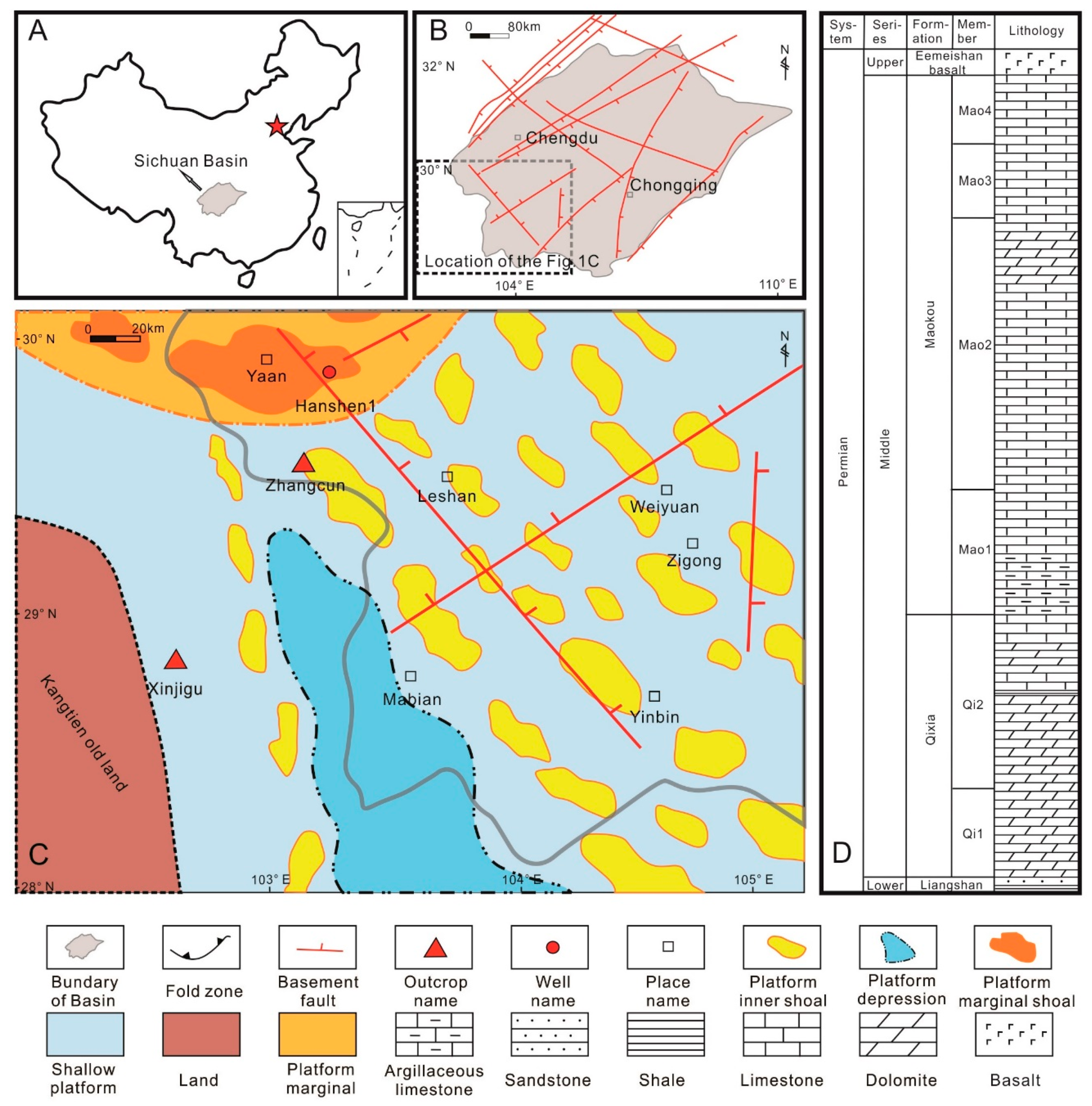
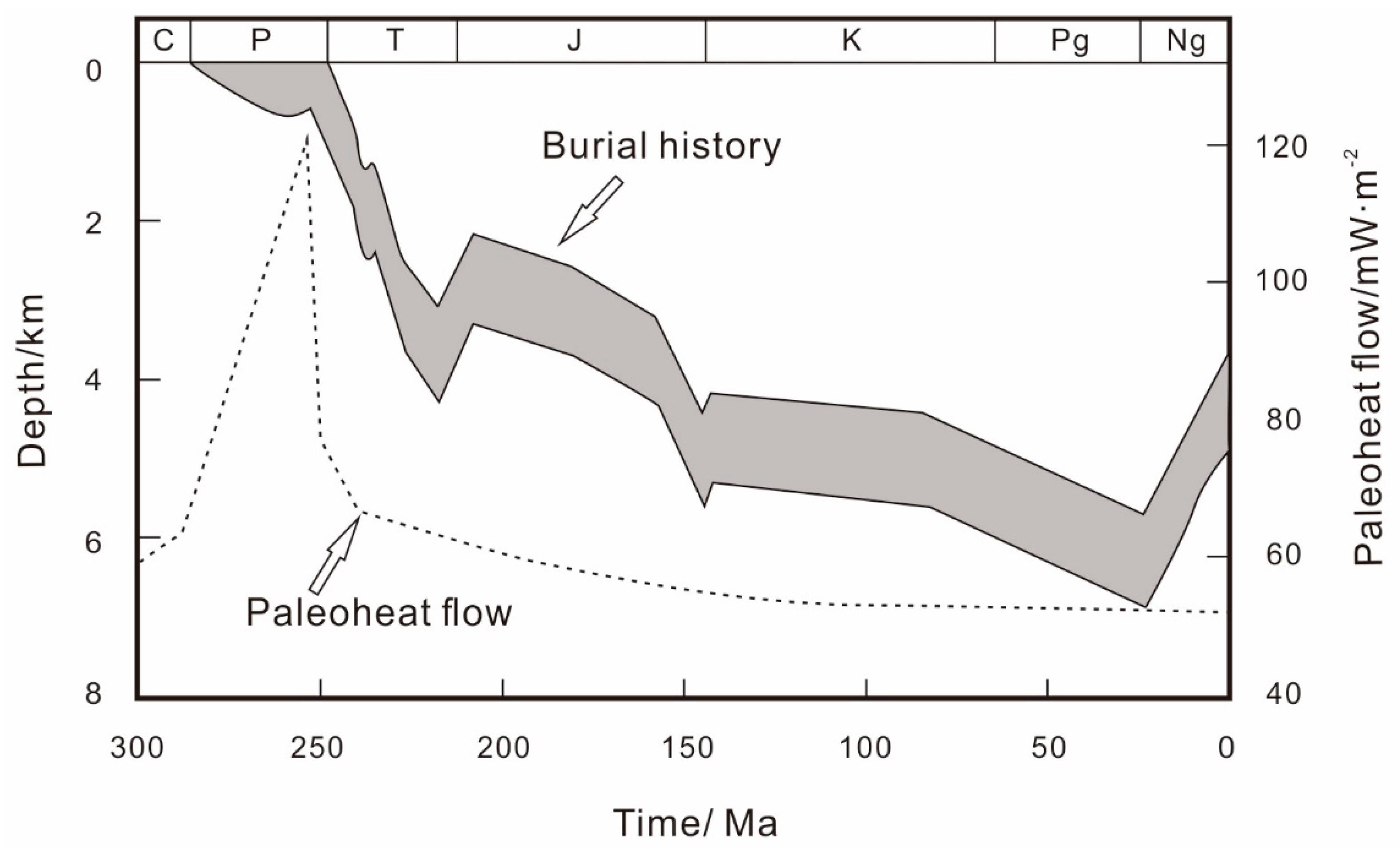
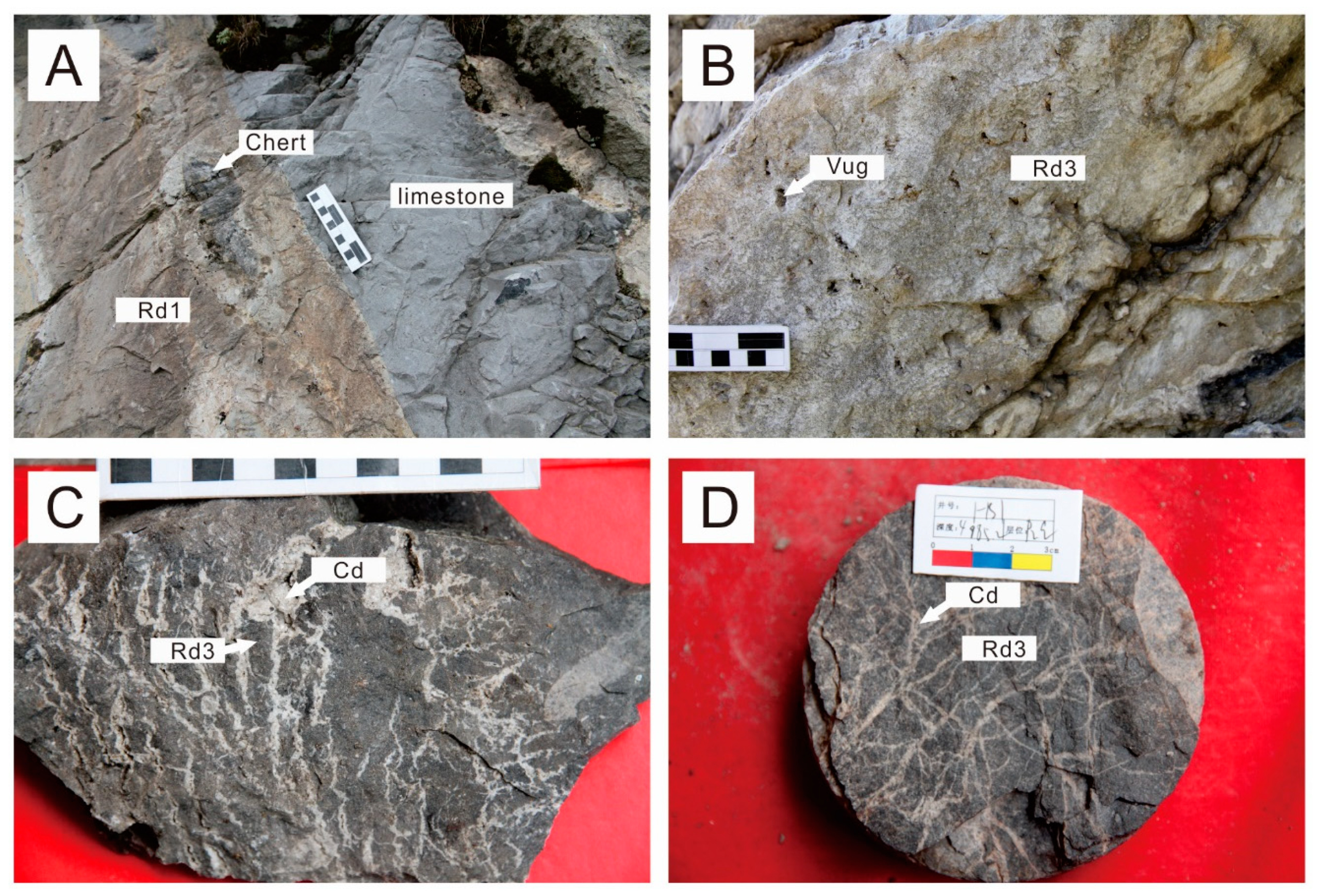
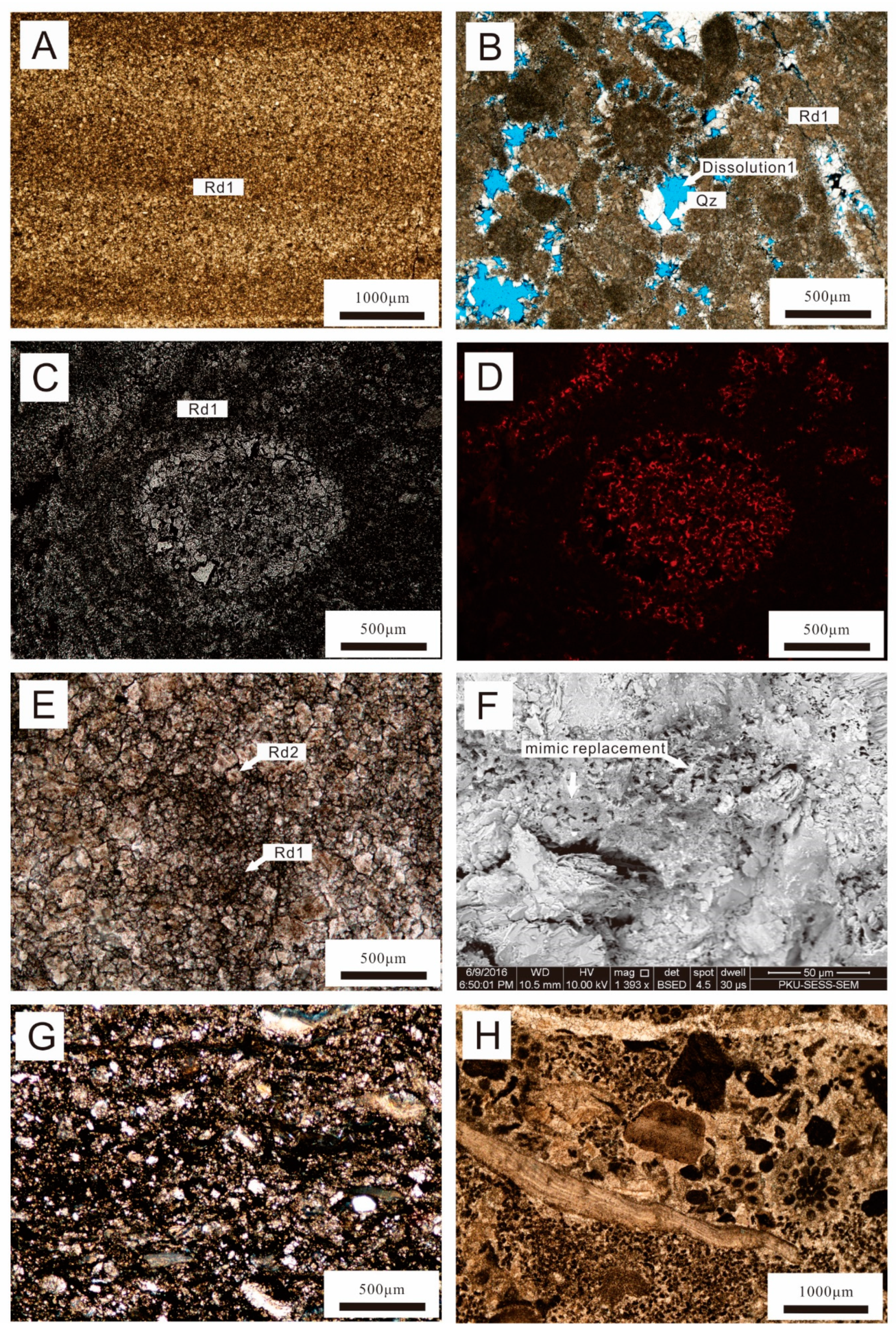
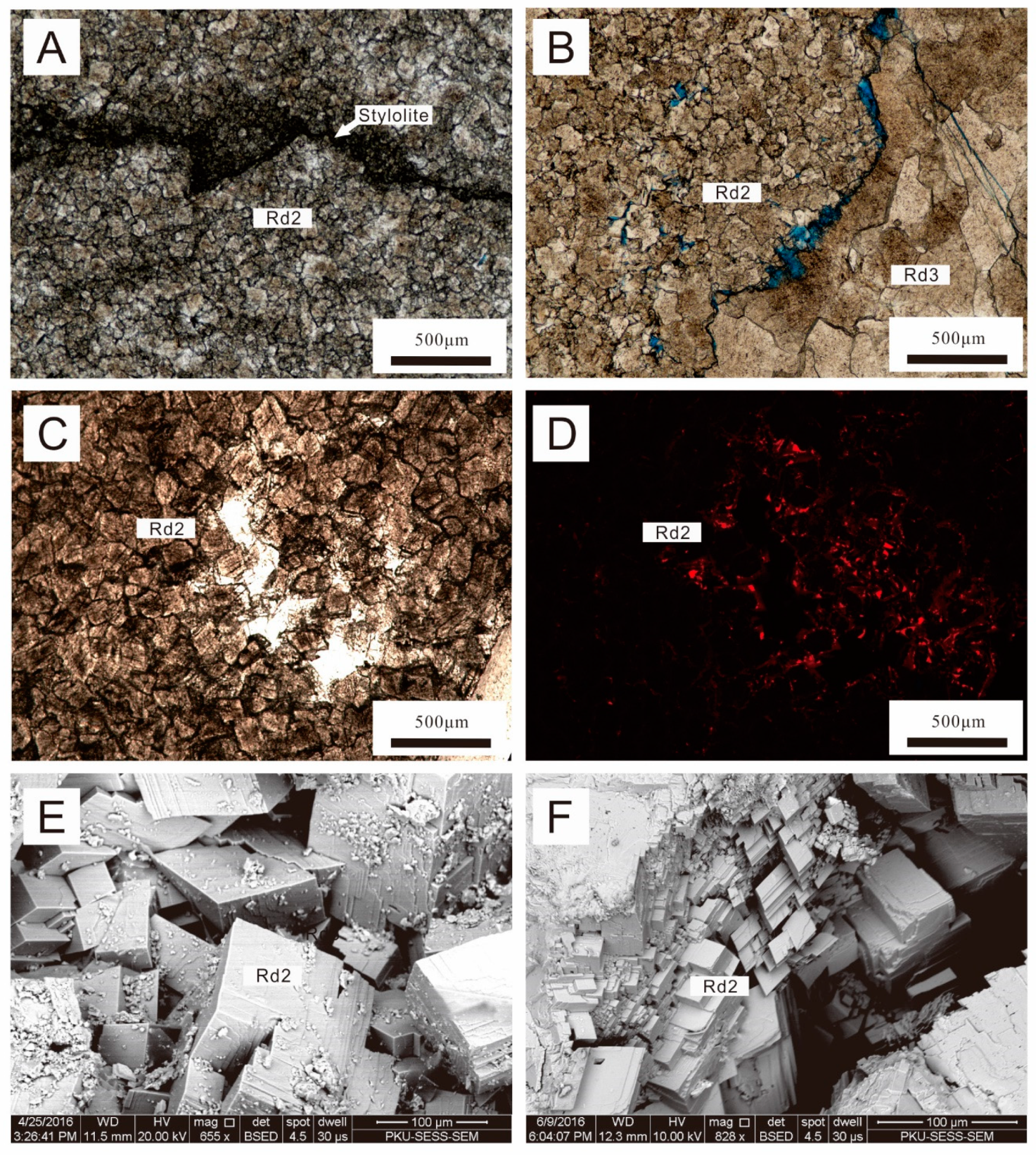
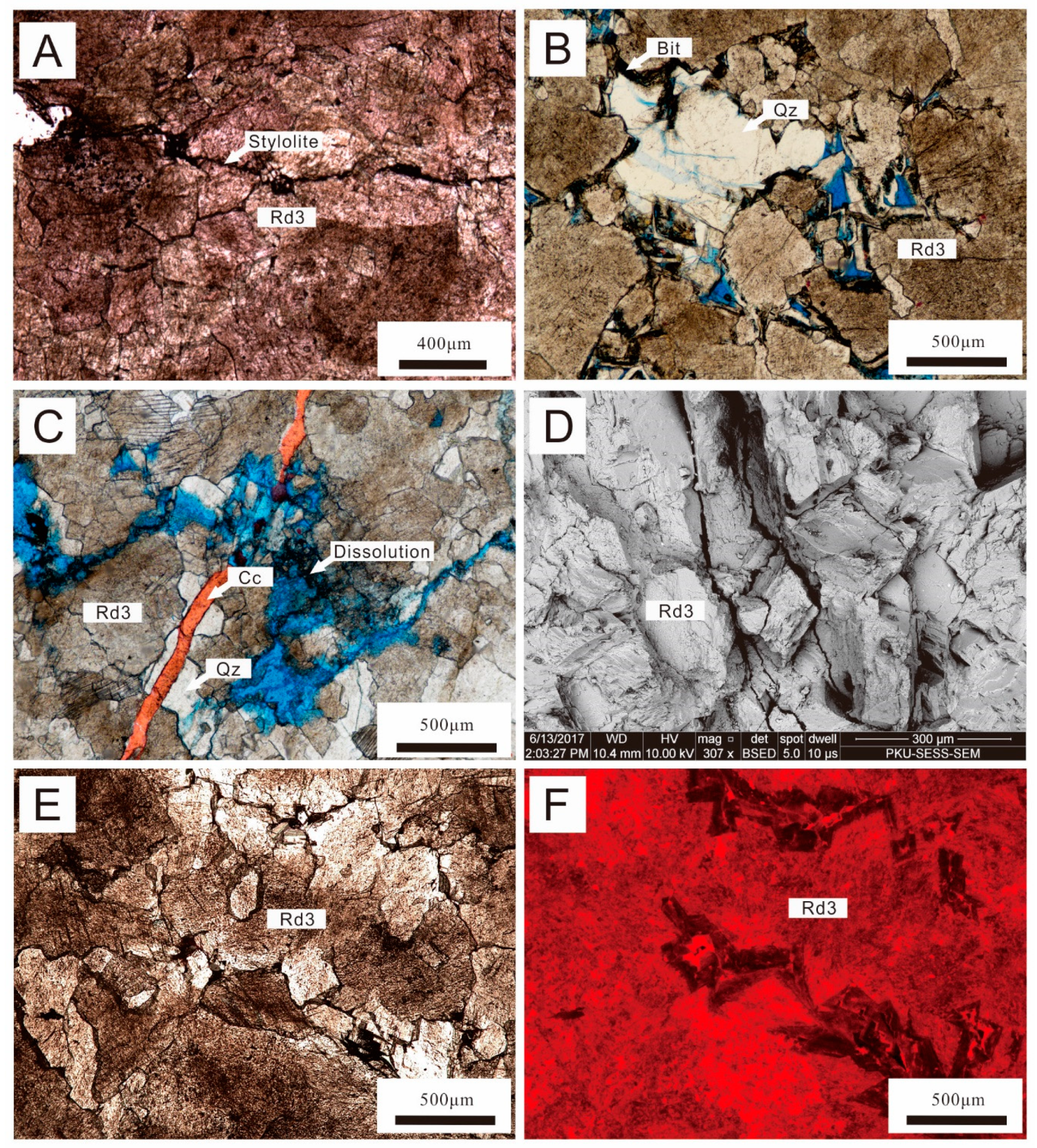
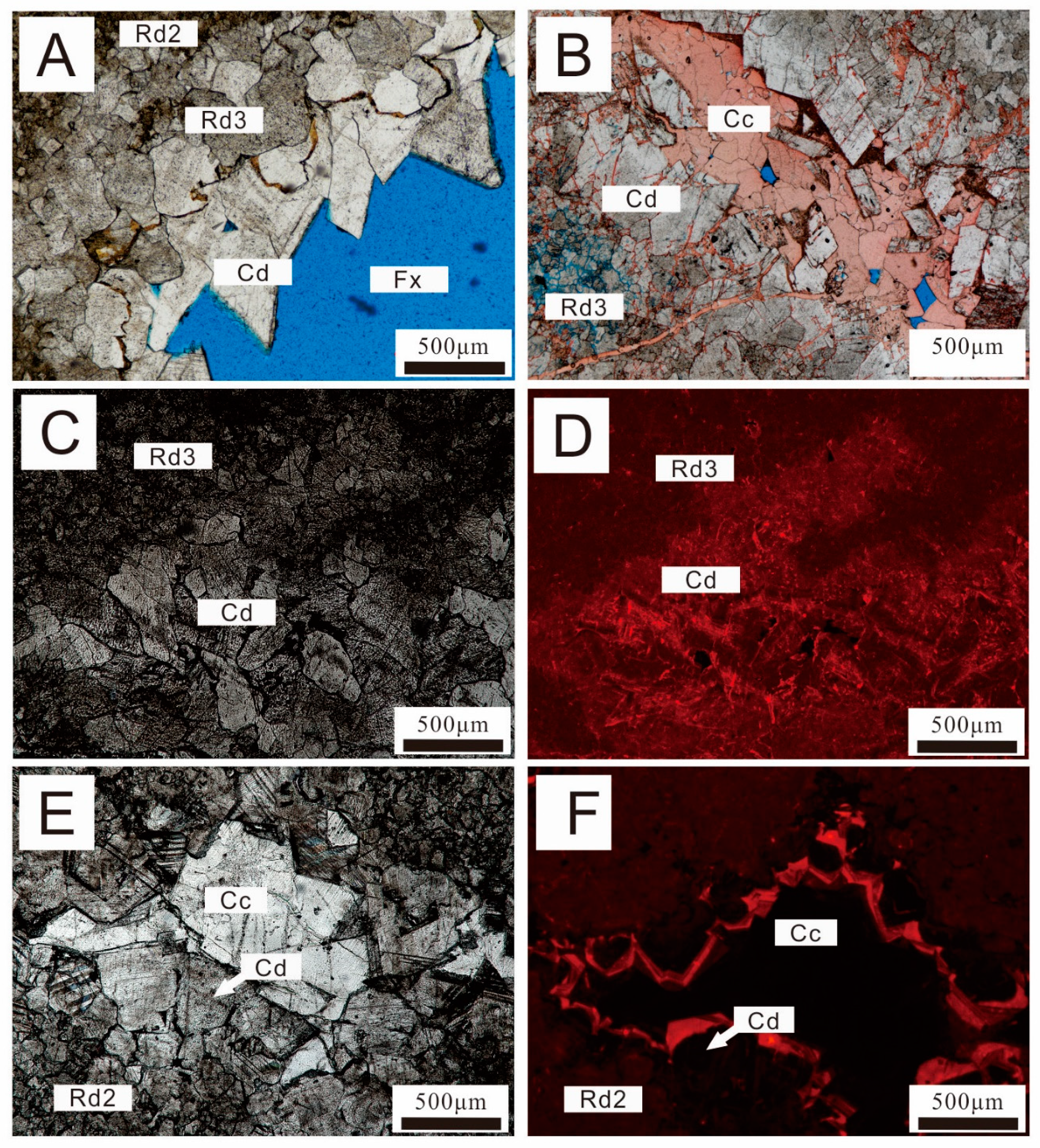
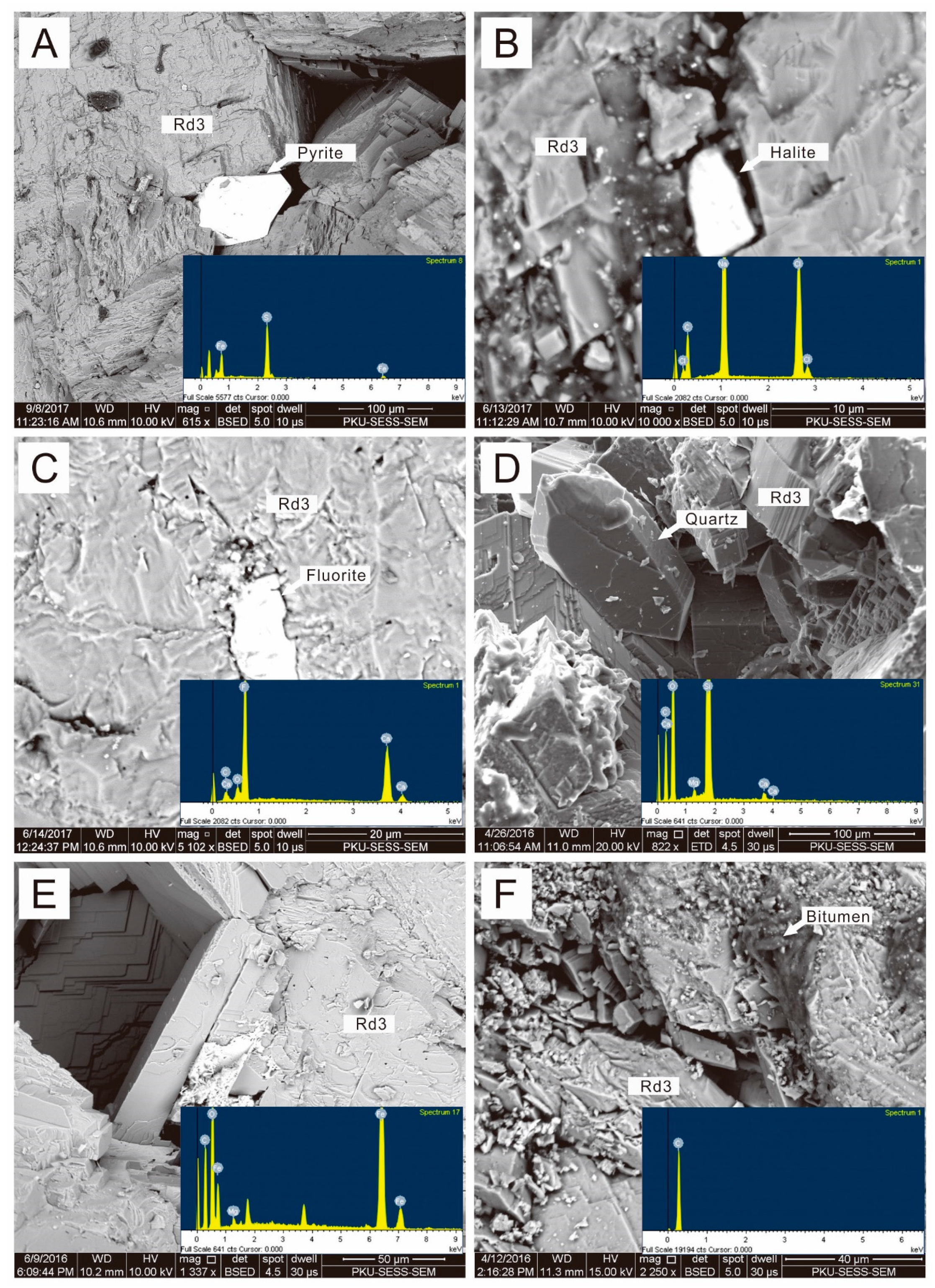
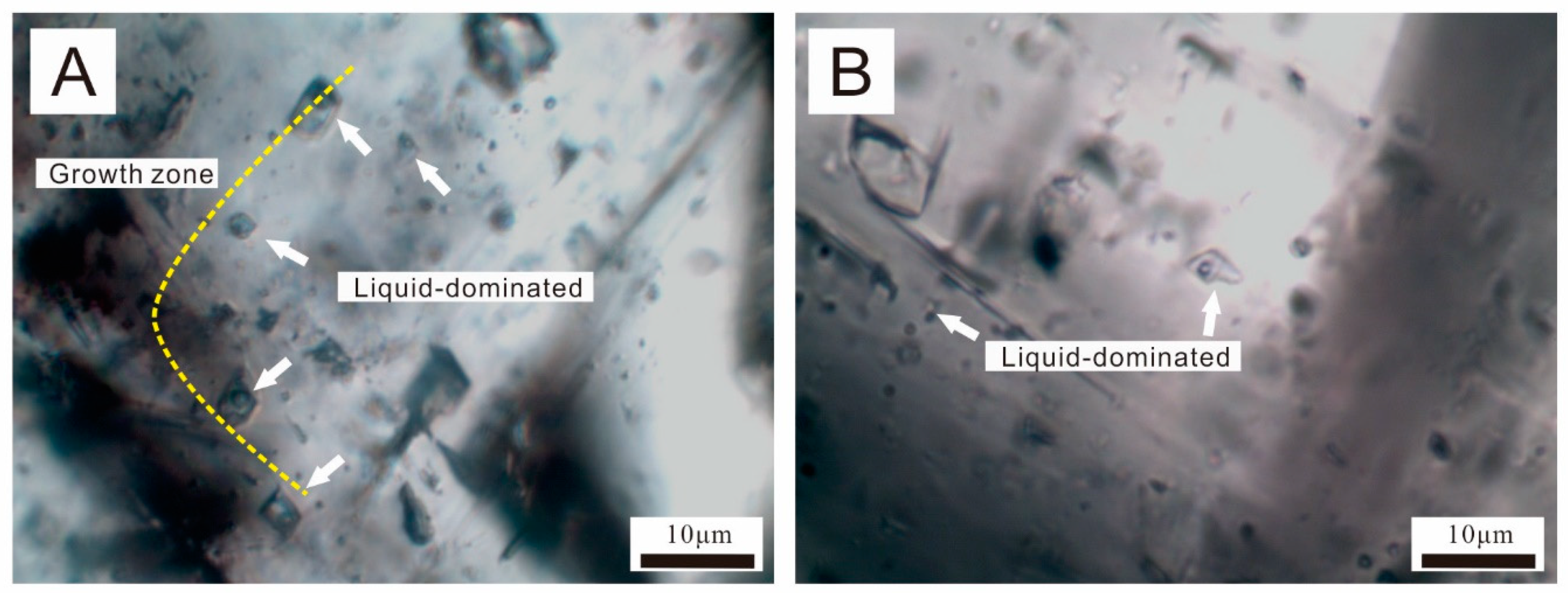
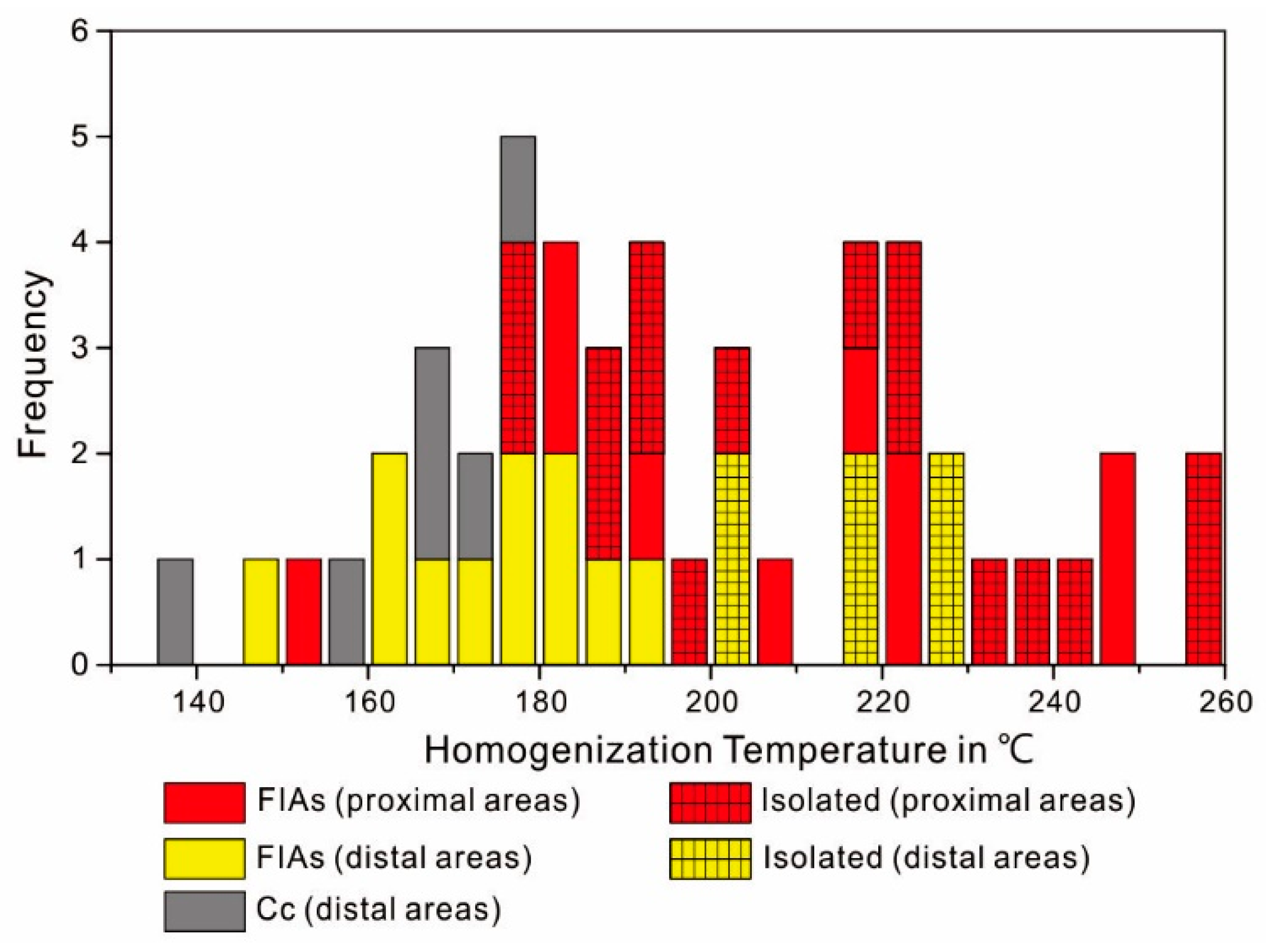
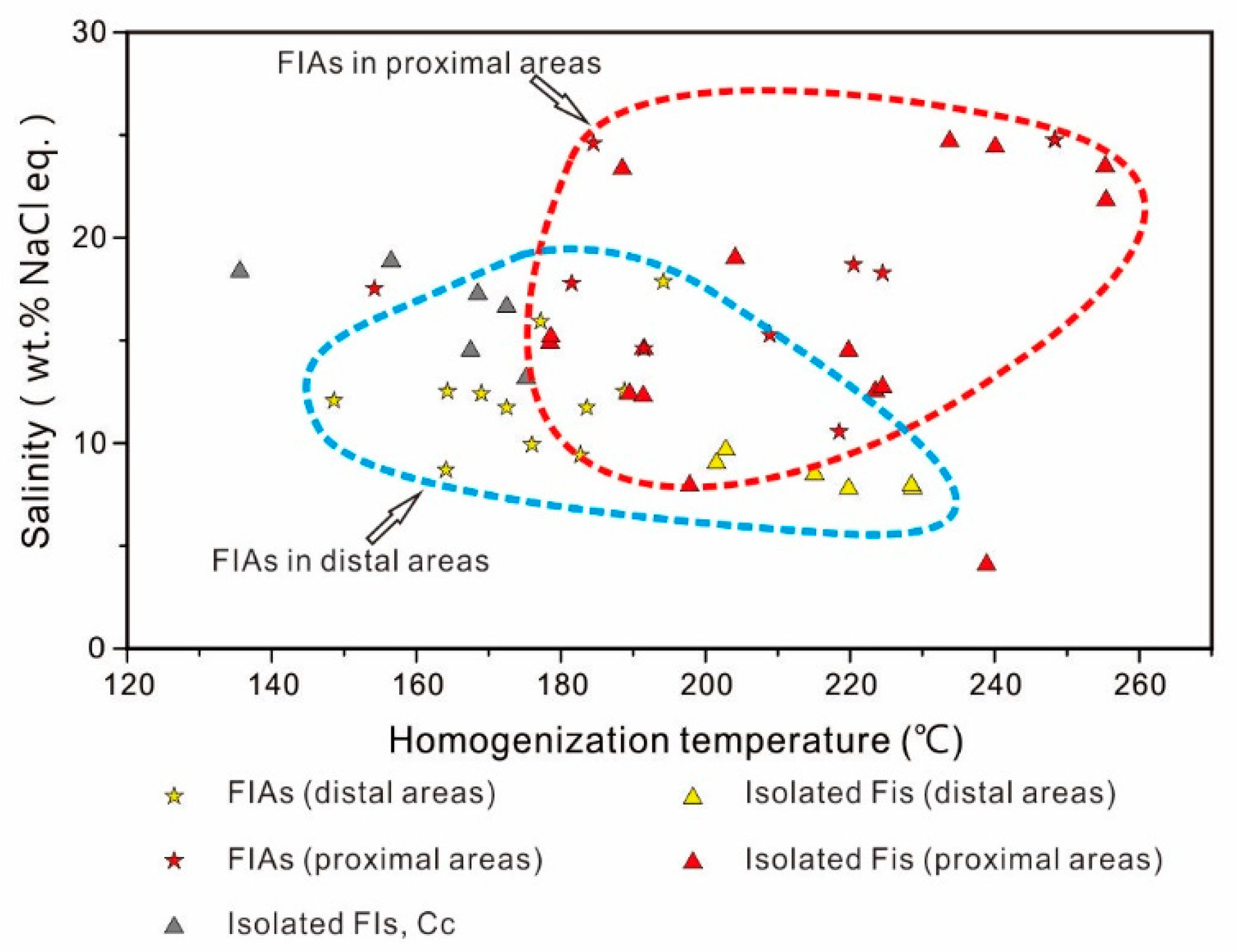
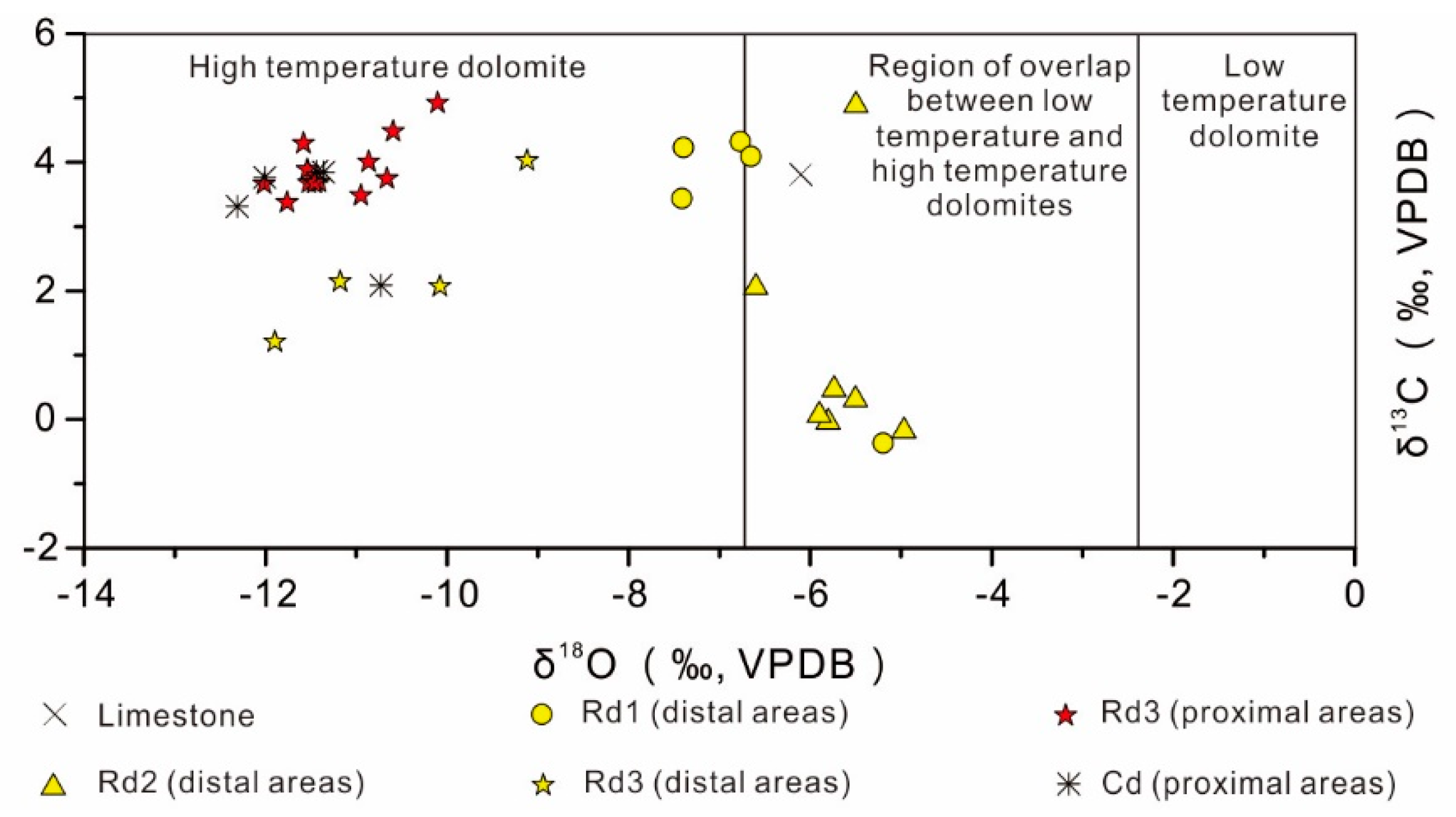
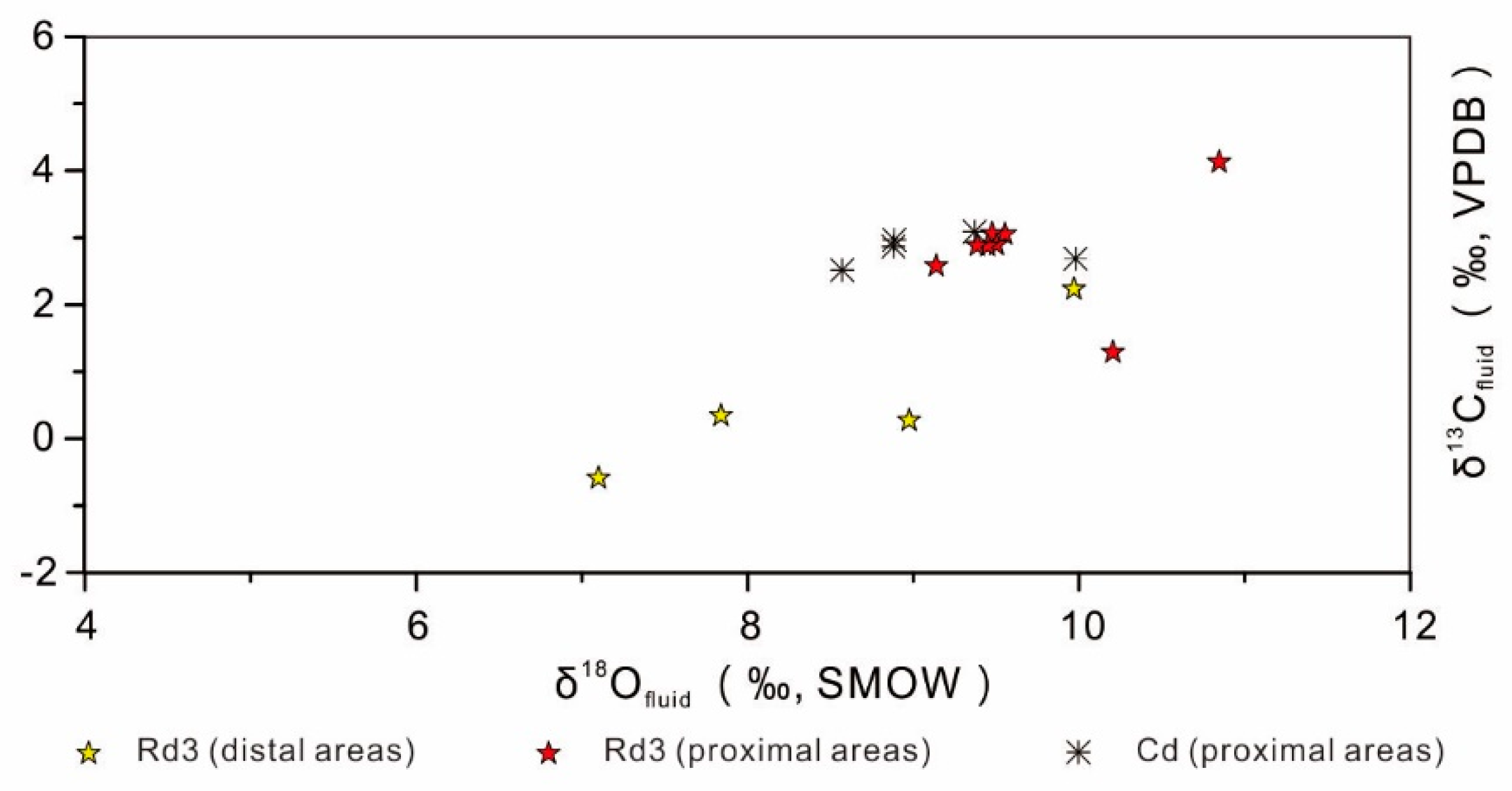
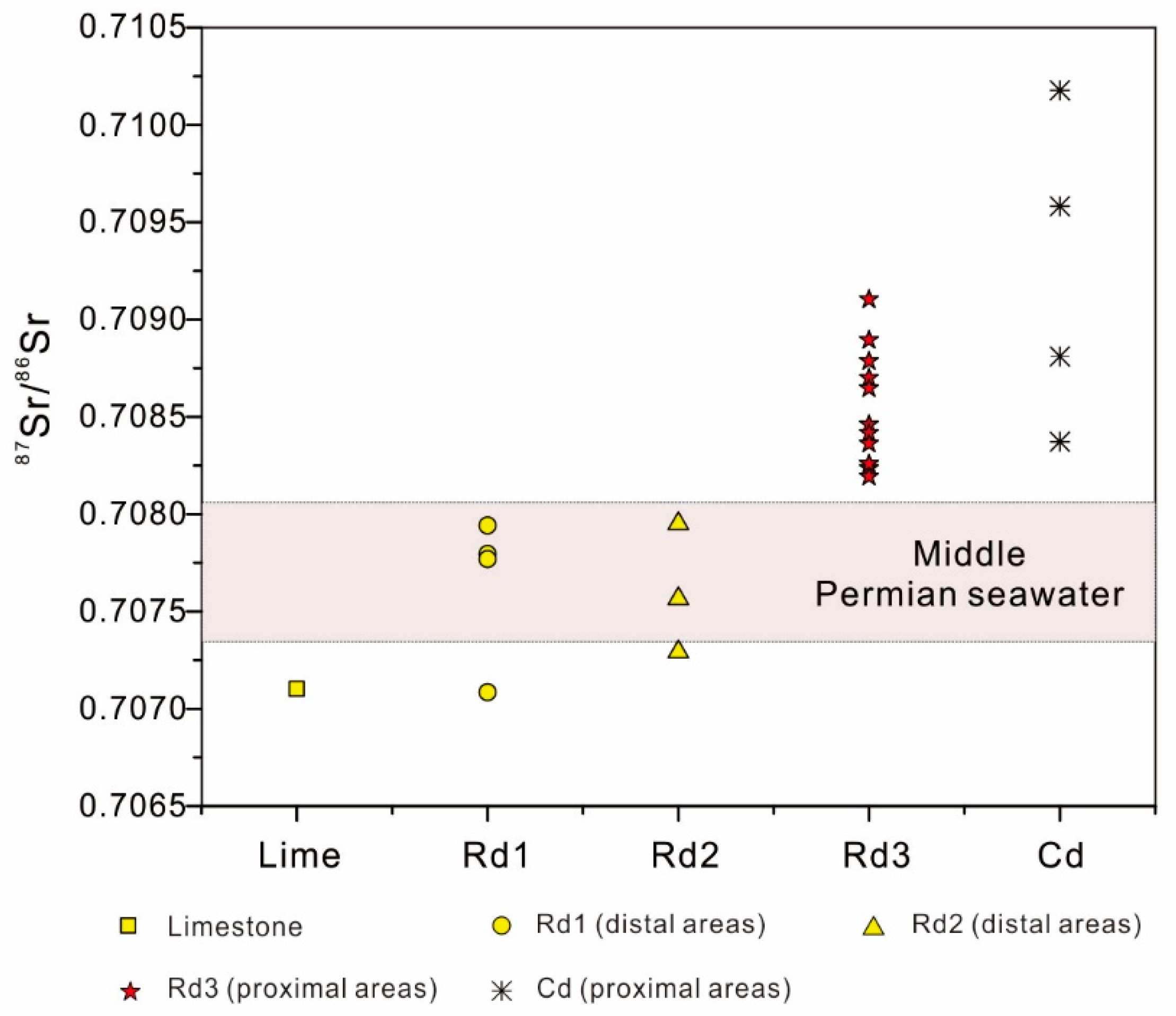
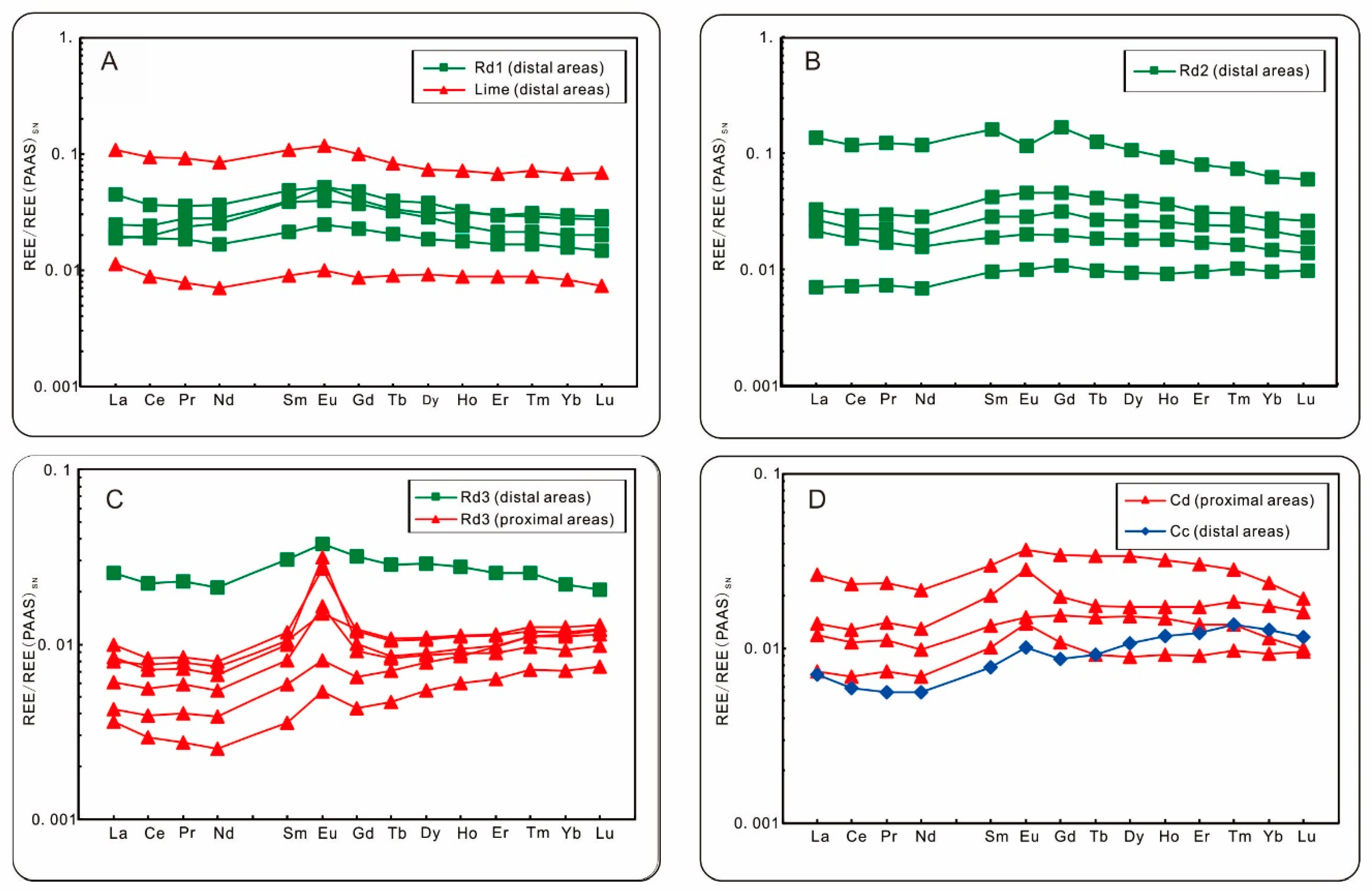
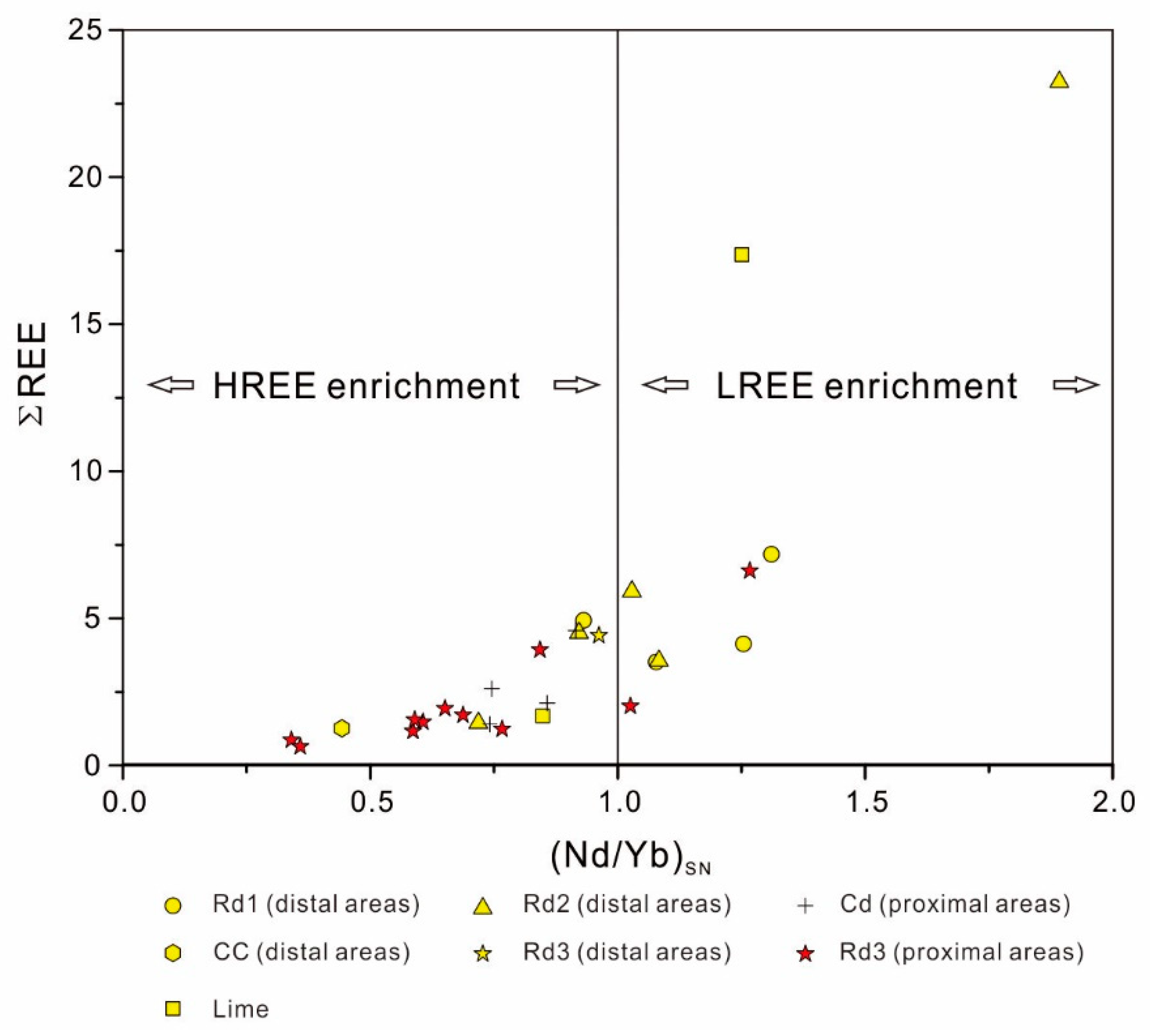
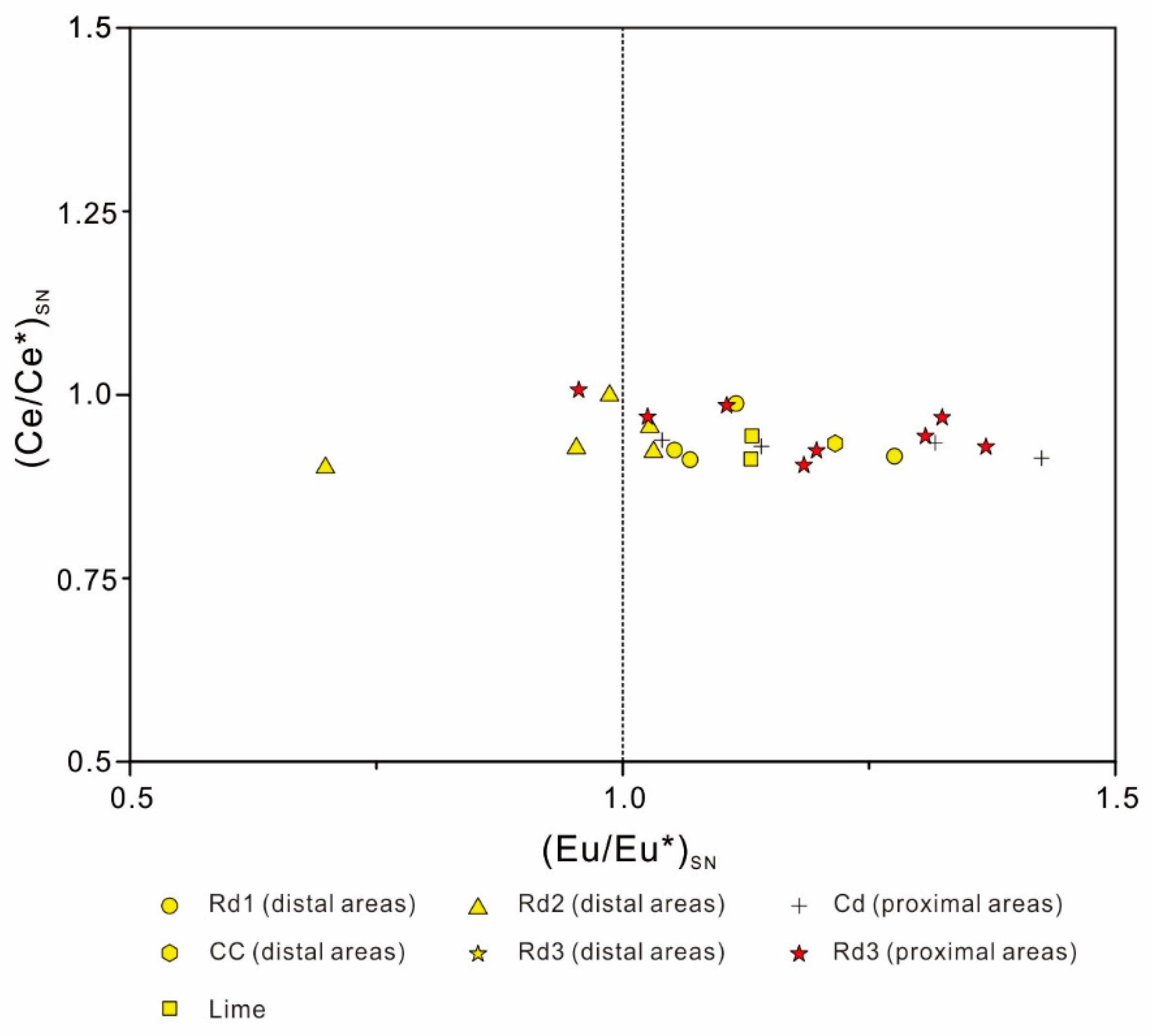
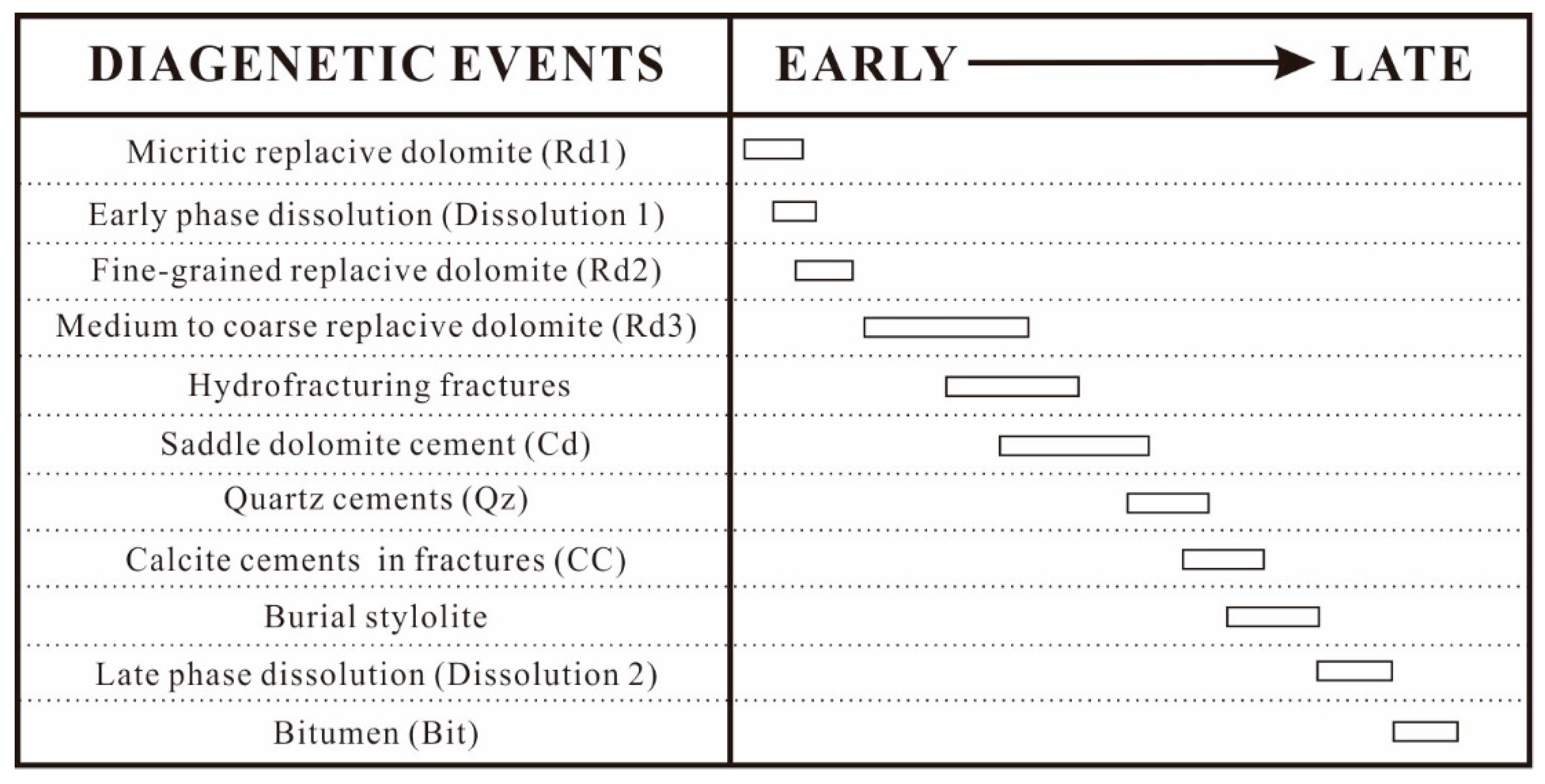
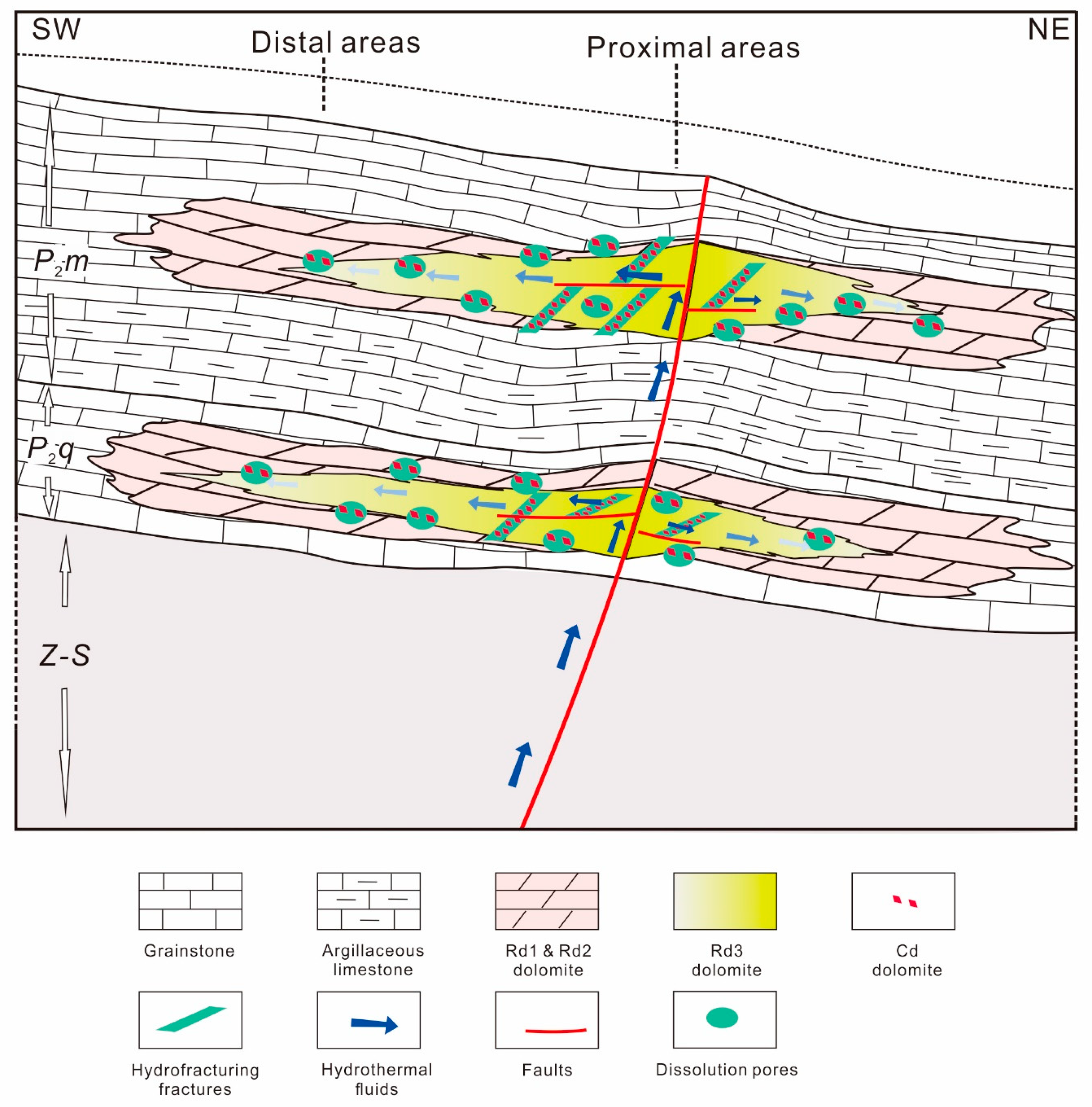
| Sample | Host Mineral | Occurrences | V (%) | Th (°C) | Tm-ice (°C) | Salinity (wt.%) |
|---|---|---|---|---|---|---|
| XJG-3-2 | Cd | Isolated | 20 | 215 | −5.3 | 8.5 |
| XJG-3-2 | Cd | Isolated | 30 | 229 | −4.8 | 7.8 |
| XJG-3-2 | Cd | Isolated | 30 | 229 | −4.9 | 7.9 |
| XJG-3-2 | Cd | Isolated | 30 | 220 | −4.8 | 7.8 |
| XJG-4-1 | Rd3 | Isolated | 30 | 203 | −6.2 | 9.7 |
| XJG-4-1 | Rd3 | Isolated | 20 | 202 | −5.7 | 9.0 |
| XJG-4-1 | Rd3 | Cluster | 30 | 149 | −8.2 | 12.1 |
| XJQ-3-1 | Cd | Cluster | 20 | 164 | −5.5 | 8.7 |
| XJQ-3-1 | Cd | Cluster | 20 | 183 | −6.0 | 9.4 |
| XJQ-3-1 | Cd | Cluster | 20 | 169 | −8.5 | 12.4 |
| XJQ-3-1 | Cd | Cluster | 20 | 164 | −8.6 | 12.5 |
| XJQ-3-1 | Cd | Cluster | 20 | 184 | −7.9 | 11.7 |
| XJQ-3-1 | Cd | Cluster | 20 | 194 | −14.2 | 17.9 |
| XJQ-3-1 | Cd | Cluster | 20 | 177 | −12.0 | 15.9 |
| XJQ-3-1 | Cd | Cluster | 20 | 176 | −6.4 | 9.9 |
| XJQ-3-1 | Cd | Cluster | 30 | 173 | −7.9 | 11.7 |
| XJQ-3-1 | Cd | Cluster | 30 | 189 | −8.6 | 12.5 |
| ZC-24 | Cd | Isolated | 30 | 239 | −2.4 | 4.1 |
| ZC-24 | Cd | Isolated | 30 | 240 | −24.3 | 24.4 |
| ZC-24 | Cd | Isolated | 20 | 192 | −10.6 | 14.6 |
| ZC-24 | Cd | Isolated | 40 | 190 | −8.5 | 12.4 |
| ZC-24 | Cd | Isolated | 20 | 198 | −4.9 | 7.9 |
| ZC-24 | Cd | Isolated | 20 | 179 | −10.9 | 14.9 |
| ZC-24 | Cd | Isolated | 20 | 179 | −11.2 | 15.2 |
| ZC-24 | Cd | Isolated | 30 | 220 | −10.5 | 14.5 |
| ZC-24 | Cd | Isolated | 20 | 224 | −8.6 | 12.5 |
| ZC-24 | Cd | Isolated | 20 | 225 | −8.8 | 12.7 |
| ZC-24 | Cd | Isolated | 30 | 191 | −8.4 | 12.3 |
| ZC-29 | Cd | Isolated | 35 | 234 | −25.1 | 24.7 |
| ZC-29 | Cd | Isolated | 40 | 255 | −21.6 | 23.5 |
| ZC-29 | Cd | Isolated | 20 | 204 | −15.6 | 19.0 |
| ZC-29 | Cd | Isolated | 20 | 189 | −21.3 | 23.4 |
| ZC-29 | Cd | Isolated | 30 | 255 | −19.2 | 21.8 |
| HS1-4973.8 | Cd | Cluster | 30 | 154 | −13.8 | 17.5 |
| HS1-4973.8 | Cd | Cluster | 20 | 192 | −10.6 | 14.6 |
| HS1-4973.8 | Cd | Cluster | 20 | 221 | −15.2 | 18.7 |
| HS1-4988.5 | Cd | Cluster | 30 | 209 | −11.3 | 15.3 |
| HS1-4988.5 | Cd | Cluster | 30 | 219 | −6.9 | 10.5 |
| HS1-4989.6 | Rd3 | Cluster | 20 | 225 | −14.7 | 18.3 |
| HS1-4989.6 | Rd3 | Cluster | 20 | 182 | −14.1 | 17.8 |
| HS1-4989.6 | Rd3 | Cluster | 20 | 248 | −25.3 | 24.8 |
| HS1-4989.6 | Rd3 | Cluster | 20 | 185 | −24.8 | 24.6 |
| HS1-4989.6 | Cd | Cluster | 20 | 248 | −25.3 | 24.8 |
| HS1-4913.4 | Cc | Isolated | 20 | 157 | −15.4 | 18.9 |
| HS1-4913.4 | Cc | Isolated | 20 | 136 | −14.8 | 18.4 |
| HS1-4913.4 | Cc | Isolated | 20 | 175 | −9.2 | 13.2 |
| HS1-4913.4 | Cc | Isolated | 10 | 168 | −10.5 | 14.5 |
| HS1-4913.4 | Cc | Isolated | 20 | 173 | −12.8 | 16.6 |
| HS1-4913.4 | Cc | Isolated | 10 | 169 | −13.5 | 17.3 |
| Sample Identification | Stable Isotopes | |||||||
|---|---|---|---|---|---|---|---|---|
| Well/Outcrop | Strata | Sample | Minerals | δ13C (‰, VPDB) | δ18O (‰, VPDB) | Cfluid (‰, VPDB) | Ofluid (‰, SMOW) | 87Sr/86Sr |
| XJG | P2q | XJG-3 | Rd1 | −0.37 | −5.19 | |||
| XJG | P2m | XJG-51 | Rd1 | 4.23 | −7.39 | 0.707795 | ||
| XJG | P2m | XJG-55 | Rd1 | 4.32 | −6.76 | 0.707941 | ||
| XJG | P2q | XJG-5-D | Rd1 | 3.44 | −7.41 | 0.707085 | ||
| XJG | P2q | XJG-19-D | Rd1 | 4.09 | −6.65 | 0.707768 | ||
| XJG | P2q | XJG-8 | Rd2 | −0.04 | −5.80 | 0.707951 | ||
| XJG | P2q | XJG-13 | Rd2 | 0.31 | −5.50 | 0.707292 | ||
| XJG | P2q | XJG-18 | Rd2 | 0.47 | −5.73 | 0.707565 | ||
| XJG | P2q | XJG-25 | Rd2 | 2.06 | −6.59 | |||
| XJG | P2m | XJG-66 | Rd2 | 4.89 | −5.49 | |||
| XJG | P2q | XJG-5 | Rd2 | 0.07 | −5.89 | |||
| XJG | P2q | XJG-6 | Rd2 | −0.18 | −4.96 | |||
| XJG | P2q | XJG-16-1B | Rd3 | 4.03 | −9.11 | 2.23 | 9.97 | |
| XJG | P2q | XJQ-8-1 | Rd3 | 1.21 | −11.89 | −0.59 | 7.10 | |
| XJG | P2q | XJG-22-1 | Rd3 | 2.14 | −11.18 | 0.34 | 7.84 | |
| XJG | P2q | XJG-25-2 | Rd3 | 2.07 | −10.07 | 0.27 | 8.98 | |
| ZC | P2q | ZC-13a | Rd3 | 4.48 | −10.59 | 0.709103 | ||
| ZC | P2q | ZC-17 | Rd3 | 4.30 | −11.58 | |||
| ZC | P2q | ZC-20 | Rd3 | 3.75 | −10.66 | |||
| ZC | P2q | ZC-22a | Rd3 | 4.01 | −10.86 | 0.708461 | ||
| ZC | P2q | ZC-23a | Rd3 | 3.69 | −11.45 | 0.708700 | ||
| HS1 | P2q | HS1-4965.5 | Rd3 | 3.69 | −11.41 | 1.29 | 10.21 | 0.708235 |
| HS1 | P2q | HS1-4966 | Rd3 | 3.68 | −11.52 | 3.05 | 9.55 | 0.708646 |
| HS1 | P2q | HS1-4971.6 | Rd3 | 3.38 | −11.76 | 3.06 | 9.48 | 0.708417 |
| HS1 | P2q | HS1-4973.8 | Rd3 | 3.48 | −10.94 | 2.89 | 9.50 | 0.708193 |
| HS1 | P2q | HS1-4977.9 | Rd3 | 3.66 | −12.01 | 2.58 | 9.14 | 0.708362 |
| HS1 | P2q | HS1-4982.6 | Rd3 | 3.89 | −11.53 | 4.12 | 10.85 | 0.708258 |
| HS1 | P2q | HS1-4989.6 | Rd3 | 3.68 | −11.46 | 2.88 | 9.45 | 0.708894 |
| HS1 | P2q | HS1-4997.2 | Rd3 | 4.92 | −10.10 | 2.88 | 9.39 | 0.708787 |
| ZC | P2q | ZC-13b | Cd | 2.09 | −10.72 | 2.86 | 8.88 | 0.719821 |
| ZC | P2q | ZC-22b | Cd | 3.85 | −11.36 | 3.09 | 9.37 | 0.710178 |
| ZC | P2q | ZC-23b | Cd | 3.86 | −11.43 | 2.51 | 8.57 | 0.709582 |
| HS1 | P2q | HS1-4967.8 | Cd | 3.77 | −12.00 | 2.97 | 8.89 | 0.708372 |
| HS1 | P2q | HS1-4971.3 | Cd | 3.31 | −12.31 | 2.68 | 9.98 | 0.708810 |
| ZC | P2q | ZC-27 | CC | 3.28 | −8.23 | |||
| XJG | P2q | XJG-16 | Qz | 0.707292 | ||||
| XJG | P2q | XJG-27 | lime | 3.81 | −6.10 | |||
| XJG | P2q | XJG-22-D | lime | 0.707102 | ||||
| Sample ID | Minerals | Rare Earth Elements (REEs) | |||||||||||||||||
|---|---|---|---|---|---|---|---|---|---|---|---|---|---|---|---|---|---|---|---|
| La | Ce | Pr | Nd | Sm | Eu | Gd | Tb | Dy | Ho | Er | Tm | Yb | Lu | ΣREE | Nd/Yb | δEu | δCe | ||
| XJG-51 | Rd1 | 0.7584 | 1.5150 | 0.1648 | 0.5698 | 0.1186 | 0.0265 | 0.1051 | 0.0159 | 0.0874 | 0.0176 | 0.0471 | 0.0067 | 0.0440 | 0.0064 | 3.4836 | 1.0777 | 1.1151 | 0.9882 |
| XJG-74 | Rd1 | 0.9433 | 1.9102 | 0.2446 | 0.9377 | 0.2202 | 0.0554 | 0.1897 | 0.0259 | 0.1454 | 0.0310 | 0.0851 | 0.0125 | 0.0838 | 0.0126 | 4.8975 | 0.9309 | 1.2760 | 0.9161 |
| XJG-5-D | Rd1 | 1.7024 | 2.9171 | 0.3164 | 1.2302 | 0.2701 | 0.0558 | 0.2238 | 0.0309 | 0.1770 | 0.0320 | 0.0850 | 0.0118 | 0.0781 | 0.0118 | 7.1423 | 1.3104 | 1.0684 | 0.9116 |
| XJG-19-D | Rd1 | 0.7217 | 1.5743 | 0.2110 | 0.8456 | 0.2131 | 0.0431 | 0.1745 | 0.0250 | 0.1336 | 0.0238 | 0.0604 | 0.0087 | 0.0561 | 0.0086 | 4.0996 | 1.2539 | 1.0525 | 0.9246 |
| XJG-27 | lime | 0.4337 | 0.6951 | 0.0688 | 0.2388 | 0.0496 | 0.0107 | 0.0400 | 0.0070 | 0.0426 | 0.0088 | 0.0250 | 0.0036 | 0.0234 | 0.0032 | 1.6502 | 0.8483 | 1.1302 | 0.9124 |
| XJG-45 | lime | 4.1007 | 7.4666 | 0.8072 | 2.8534 | 0.5947 | 0.1263 | 0.4641 | 0.0635 | 0.3424 | 0.0716 | 0.1907 | 0.0290 | 0.1898 | 0.0298 | 17.3299 | 1.2509 | 1.1311 | 0.9438 |
| XJG-13 | Rd2 | 0.8482 | 1.5137 | 0.1551 | 0.5533 | 0.1084 | 0.0222 | 0.0951 | 0.0148 | 0.0874 | 0.0184 | 0.0500 | 0.0068 | 0.0425 | 0.0062 | 3.5222 | 1.0830 | 1.0276 | 0.9563 |
| XJG-18 | Rd2 | 1.0565 | 1.8579 | 0.2004 | 0.6842 | 0.1613 | 0.0316 | 0.1509 | 0.0213 | 0.1260 | 0.0260 | 0.0711 | 0.0098 | 0.0618 | 0.0085 | 4.4673 | 0.9215 | 0.9530 | 0.9271 |
| XJG-25 | Rd2 | 5.3638 | 9.5941 | 1.1239 | 4.0961 | 0.9209 | 0.1278 | 0.8066 | 0.1000 | 0.5068 | 0.0932 | 0.2351 | 0.0307 | 0.1801 | 0.0264 | 23.2054 | 1.8922 | 0.6983 | 0.9005 |
| XJG-66 | Rd2 | 0.2755 | 0.5841 | 0.0660 | 0.2398 | 0.0548 | 0.0112 | 0.0517 | 0.0078 | 0.0452 | 0.0094 | 0.0280 | 0.0042 | 0.0278 | 0.0044 | 1.4098 | 0.7181 | 0.9868 | 0.9990 |
| XJG-8 | Rd2 | 1.2915 | 2.3717 | 0.2721 | 0.9877 | 0.2419 | 0.0506 | 0.2206 | 0.0327 | 0.1850 | 0.0370 | 0.0901 | 0.0125 | 0.0799 | 0.0118 | 5.8851 | 1.0285 | 1.0313 | 0.9222 |
| XJG-5 | Rd3 | 0.9832 | 1.7842 | 0.2012 | 0.7176 | 0.1698 | 0.0403 | 0.1480 | 0.0222 | 0.1354 | 0.0276 | 0.0734 | 0.0103 | 0.0621 | 0.0089 | 4.3841 | 0.9618 | 1.1969 | 0.9238 |
| ZC-13a | Rd3 | 0.3903 | 0.7501 | 0.0939 | 0.3308 | 0.0686 | 0.0170 | 0.0661 | 0.0110 | 0.0677 | 0.0139 | 0.0400 | 0.0062 | 0.0423 | 0.0072 | 1.9049 | 0.6507 | 1.1840 | 0.9040 |
| ZC-17 | Rd3 | 1.4960 | 2.9324 | 0.3146 | 1.0653 | 0.2219 | 0.0445 | 0.1611 | 0.0232 | 0.1347 | 0.0260 | 0.0720 | 0.0106 | 0.0699 | 0.0107 | 6.5830 | 1.2668 | 1.1056 | 0.9852 |
| ZC-22a | Rd3 | 0.4115 | 0.8315 | 0.0951 | 0.3443 | 0.0748 | 0.0148 | 0.0615 | 0.0096 | 0.0576 | 0.0111 | 0.0293 | 0.0042 | 0.0279 | 0.0044 | 1.9776 | 1.0253 | 1.0253 | 0.9697 |
| ZC-23a | Rd3 | 0.7482 | 1.6726 | 0.1958 | 0.6801 | 0.1421 | 0.0274 | 0.1280 | 0.0197 | 0.1129 | 0.0223 | 0.0601 | 0.0095 | 0.0671 | 0.0093 | 3.8951 | 0.8426 | 0.9554 | 1.0063 |
| HS1-4965.5 | Rd3 | 0.3820 | 0.6587 | 0.0741 | 0.2711 | 0.0650 | 0.0292 | 0.0550 | 0.0081 | 0.0498 | 0.0110 | 0.0321 | 0.0048 | 0.0328 | 0.0053 | 1.6791 | 0.6870 | 2.2961 | 0.9000 |
| HS1-4997.2 | Rd3 | 0.3202 | 0.5684 | 0.0638 | 0.2272 | 0.0550 | 0.0338 | 0.0466 | 0.0066 | 0.0419 | 0.0093 | 0.0279 | 0.0045 | 0.0312 | 0.0049 | 1.4413 | 0.6061 | 3.1444 | 0.9150 |
| HS-4989.6 | Rd3 | 0.1621 | 0.3103 | 0.0355 | 0.1310 | 0.0328 | 0.0087 | 0.0302 | 0.0055 | 0.0370 | 0.0085 | 0.0274 | 0.0045 | 0.0320 | 0.0052 | 0.8310 | 0.3401 | 1.3072 | 0.9434 |
| HS-4966 | Rd3 | 0.2304 | 0.4456 | 0.0521 | 0.1843 | 0.0451 | 0.0177 | 0.0425 | 0.0064 | 0.0404 | 0.0088 | 0.0255 | 0.0039 | 0.0262 | 0.0042 | 1.1331 | 0.5861 | 1.9028 | 0.9381 |
| HS-4977.9 | Rd3 | 0.3054 | 0.6117 | 0.0694 | 0.2516 | 0.0581 | 0.0162 | 0.0567 | 0.0084 | 0.0513 | 0.0111 | 0.0325 | 0.0050 | 0.0355 | 0.0055 | 1.5185 | 0.5897 | 1.3243 | 0.9689 |
| HS-4982.6 | Rd3 | 0.1380 | 0.2348 | 0.0242 | 0.0859 | 0.0197 | 0.0058 | 0.0200 | 0.0036 | 0.0253 | 0.0059 | 0.0181 | 0.0029 | 0.0200 | 0.0032 | 0.6075 | 0.3582 | 1.3688 | 0.9289 |
| ZC-13b | Cd | 0.5319 | 1.0198 | 0.1247 | 0.4390 | 0.1108 | 0.0307 | 0.0926 | 0.0136 | 0.0808 | 0.0170 | 0.0491 | 0.0075 | 0.0490 | 0.0070 | 2.5734 | 0.7455 | 1.4250 | 0.9135 |
| ZC-22b | Cd | 0.4564 | 0.8604 | 0.0980 | 0.3315 | 0.0751 | 0.0163 | 0.0720 | 0.0116 | 0.0709 | 0.0148 | 0.0391 | 0.0055 | 0.0322 | 0.0043 | 2.0879 | 0.8573 | 1.0399 | 0.9382 |
| ZC-23b | Cd | 1.0032 | 1.8517 | 0.2099 | 0.7320 | 0.1655 | 0.0394 | 0.1590 | 0.0261 | 0.1578 | 0.0316 | 0.0859 | 0.0115 | 0.0665 | 0.0084 | 4.5484 | 0.9150 | 1.1407 | 0.9299 |
| HS1-4971.3 | Cd | 0.2811 | 0.5469 | 0.0649 | 0.2341 | 0.0561 | 0.0149 | 0.0508 | 0.0071 | 0.0416 | 0.0091 | 0.0258 | 0.0039 | 0.0263 | 0.0042 | 1.3667 | 0.7415 | 1.3171 | 0.9345 |
| XJG-70 | Cc | 0.2711 | 0.4734 | 0.0498 | 0.1912 | 0.0433 | 0.0108 | 0.0407 | 0.0071 | 0.0498 | 0.0116 | 0.0350 | 0.0055 | 0.0360 | 0.0050 | 1.2302 | 0.4423 | 1.2158 | 0.9337 |
© 2019 by the authors. Licensee MDPI, Basel, Switzerland. This article is an open access article distributed under the terms and conditions of the Creative Commons Attribution (CC BY) license (http://creativecommons.org/licenses/by/4.0/).
Share and Cite
Zheng, H.; Ma, Y.; Chi, G.; Qing, H.; Liu, B.; Zhang, X.; Shen, Y.; Liu, J.; Wang, Y. Stratigraphic and Structural Control on Hydrothermal Dolomitization in the Middle Permian Carbonates, Southwestern Sichuan Basin (China). Minerals 2019, 9, 32. https://doi.org/10.3390/min9010032
Zheng H, Ma Y, Chi G, Qing H, Liu B, Zhang X, Shen Y, Liu J, Wang Y. Stratigraphic and Structural Control on Hydrothermal Dolomitization in the Middle Permian Carbonates, Southwestern Sichuan Basin (China). Minerals. 2019; 9(1):32. https://doi.org/10.3390/min9010032
Chicago/Turabian StyleZheng, Haofu, Yongsheng Ma, Guoxiang Chi, Hairuo Qing, Bo Liu, Xuefeng Zhang, Yingchu Shen, Jianqiang Liu, and Yuanchong Wang. 2019. "Stratigraphic and Structural Control on Hydrothermal Dolomitization in the Middle Permian Carbonates, Southwestern Sichuan Basin (China)" Minerals 9, no. 1: 32. https://doi.org/10.3390/min9010032
APA StyleZheng, H., Ma, Y., Chi, G., Qing, H., Liu, B., Zhang, X., Shen, Y., Liu, J., & Wang, Y. (2019). Stratigraphic and Structural Control on Hydrothermal Dolomitization in the Middle Permian Carbonates, Southwestern Sichuan Basin (China). Minerals, 9(1), 32. https://doi.org/10.3390/min9010032






